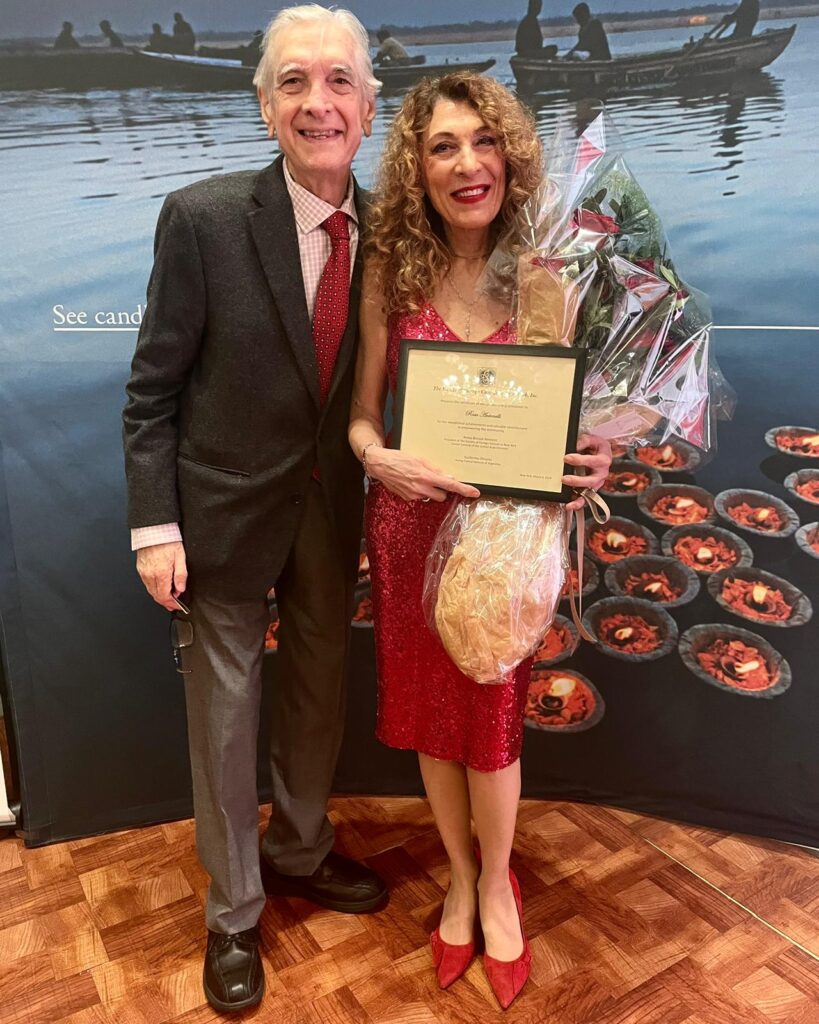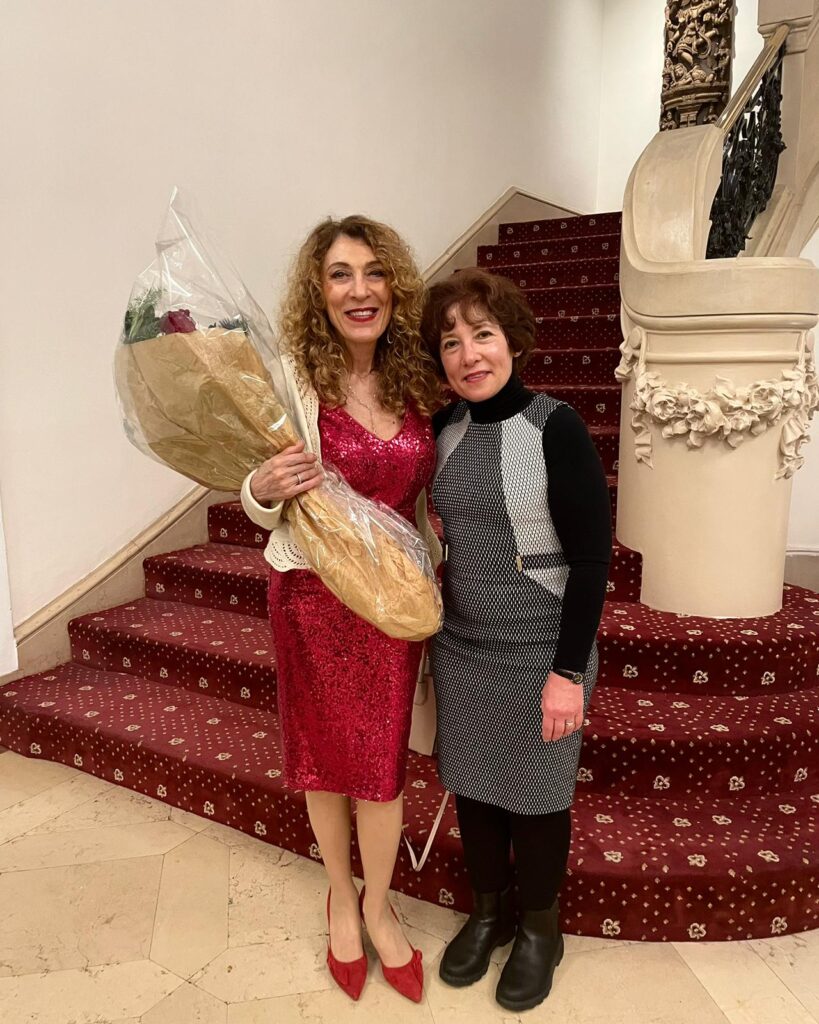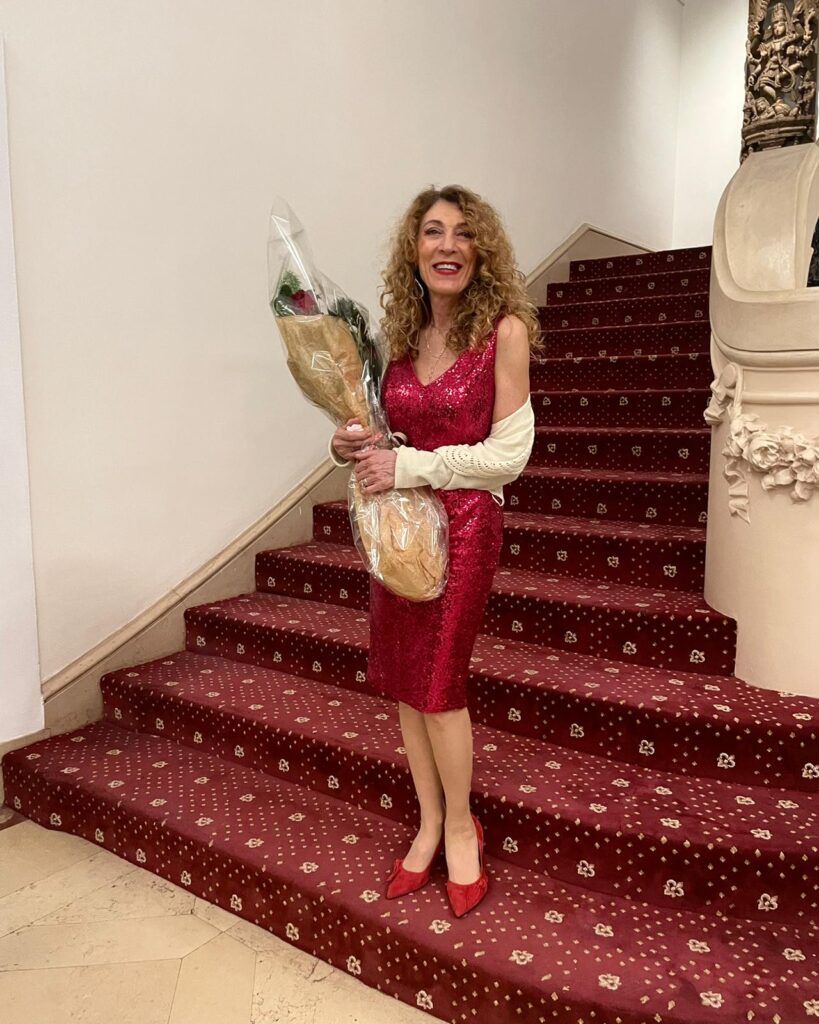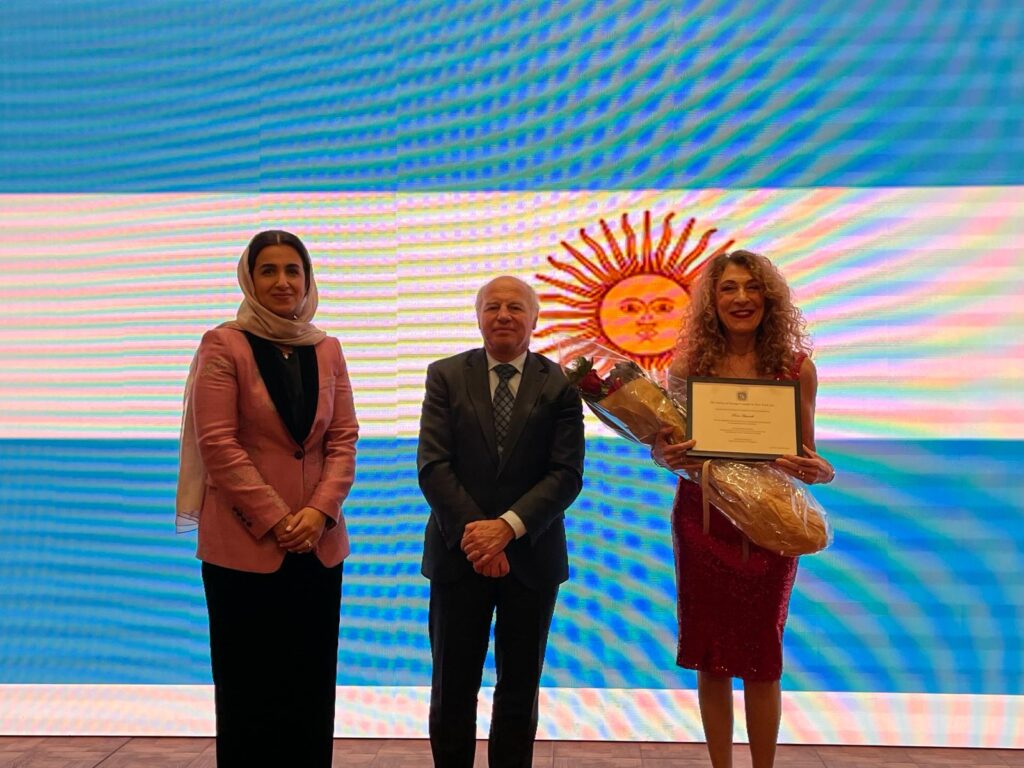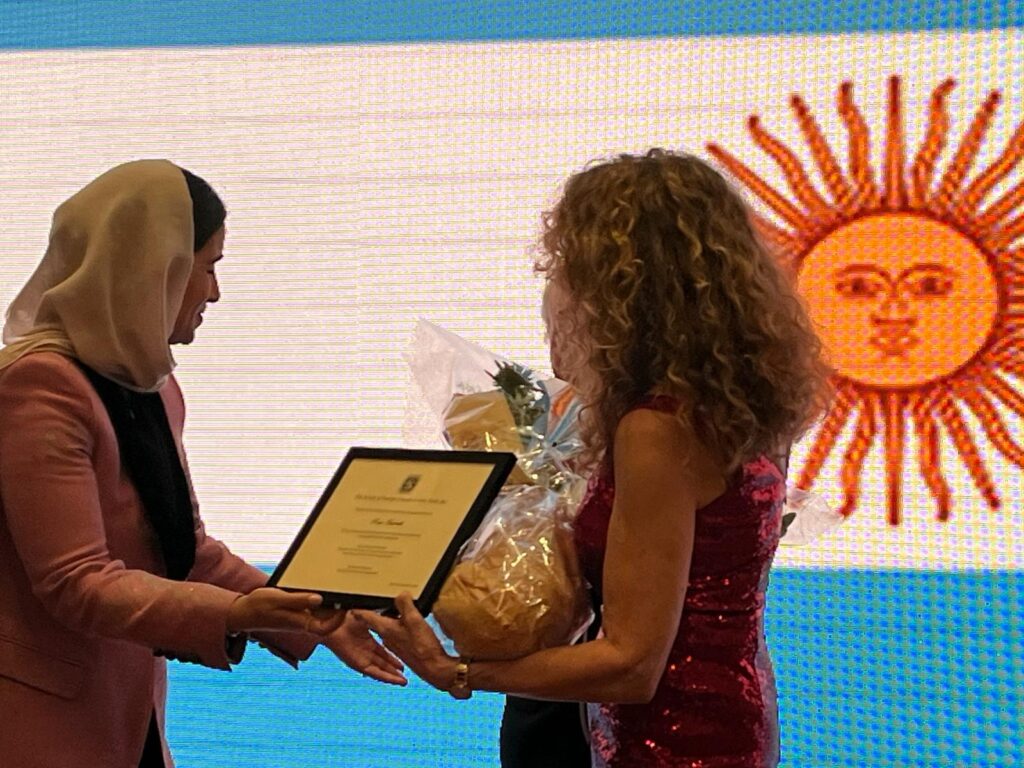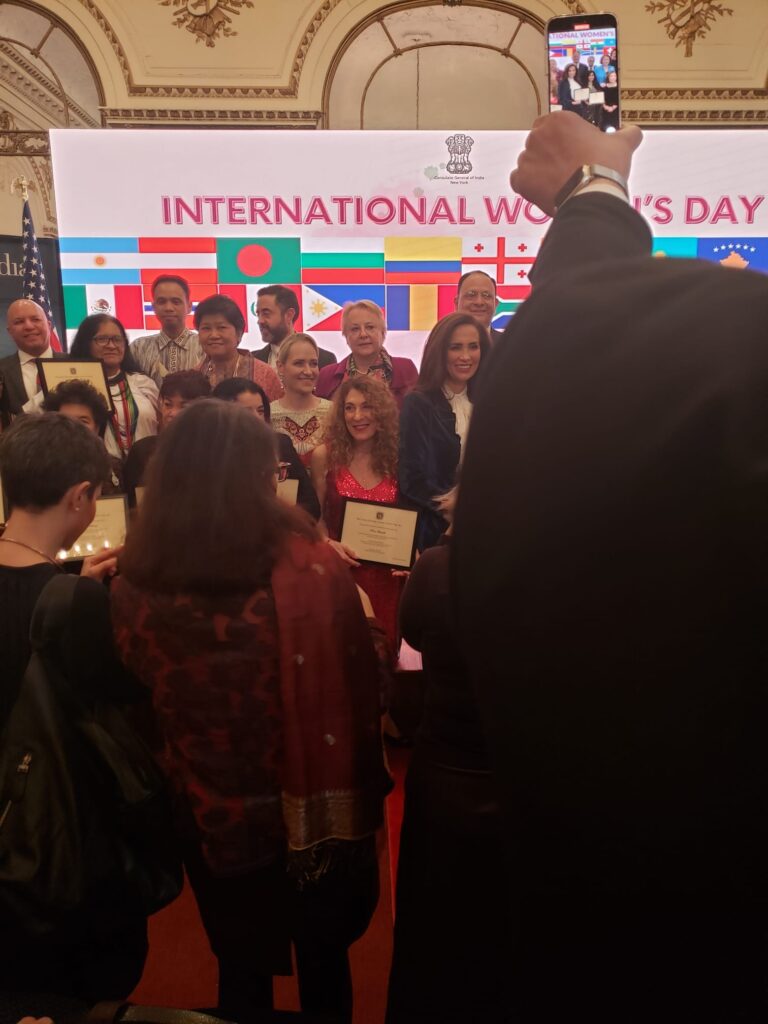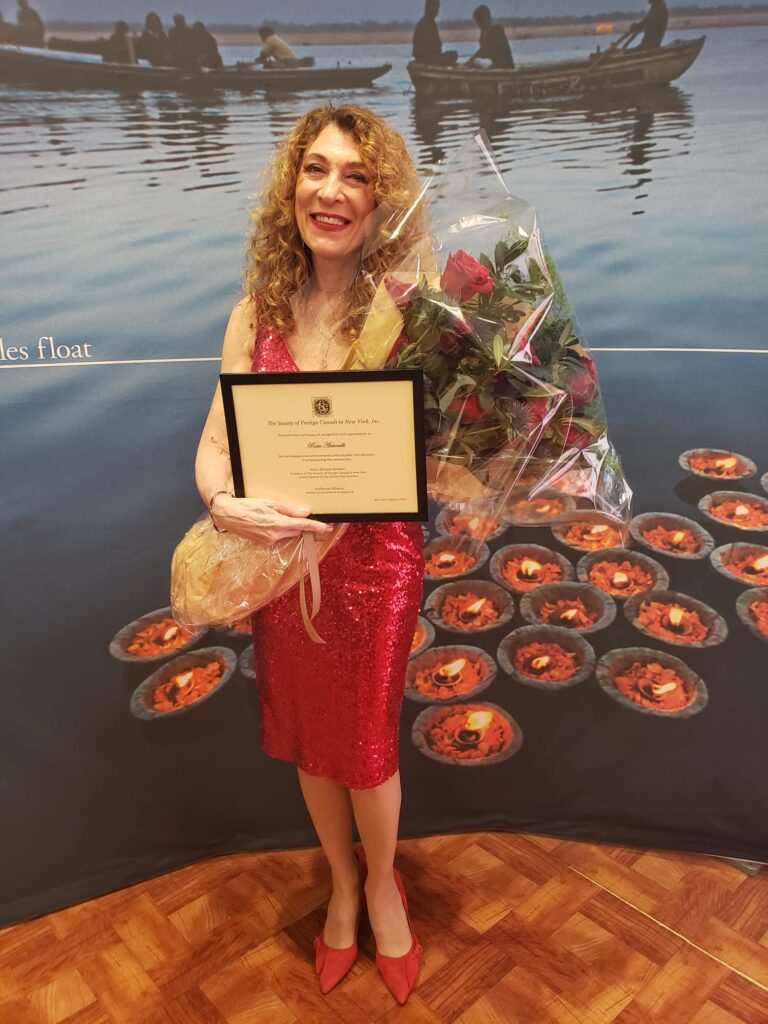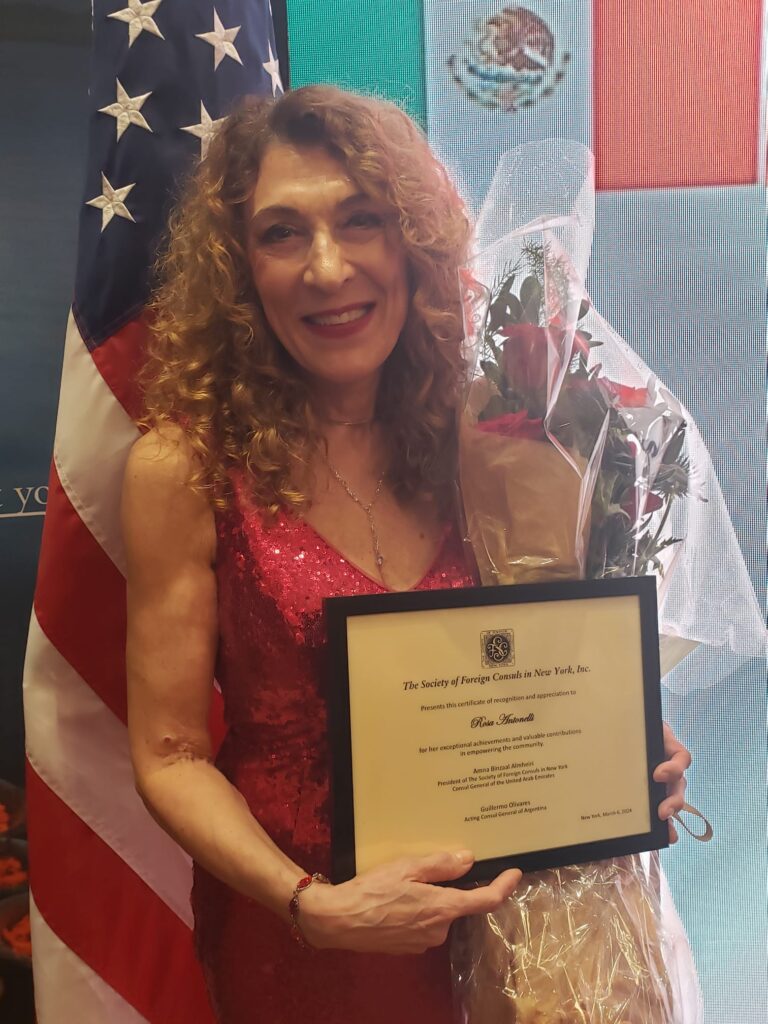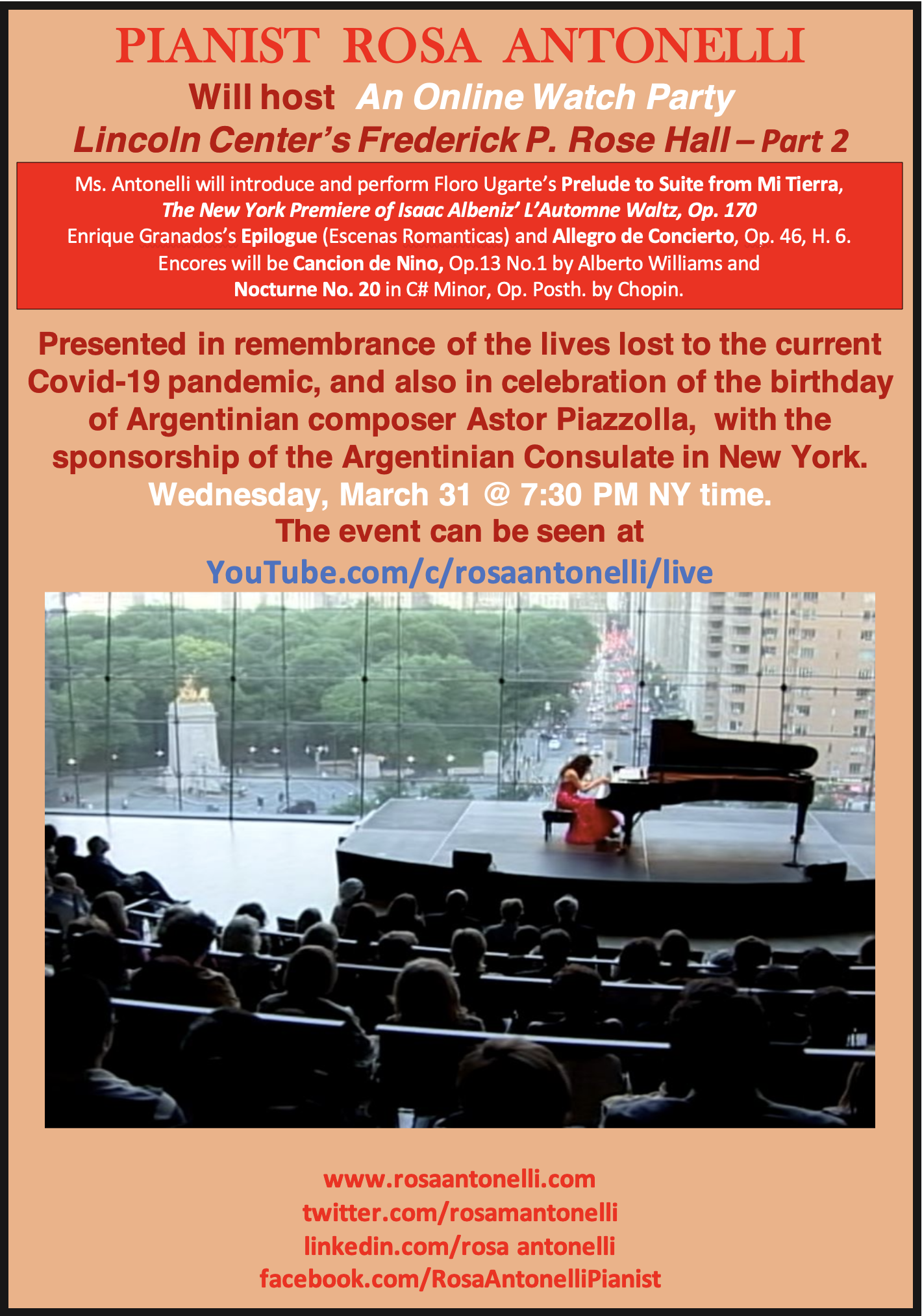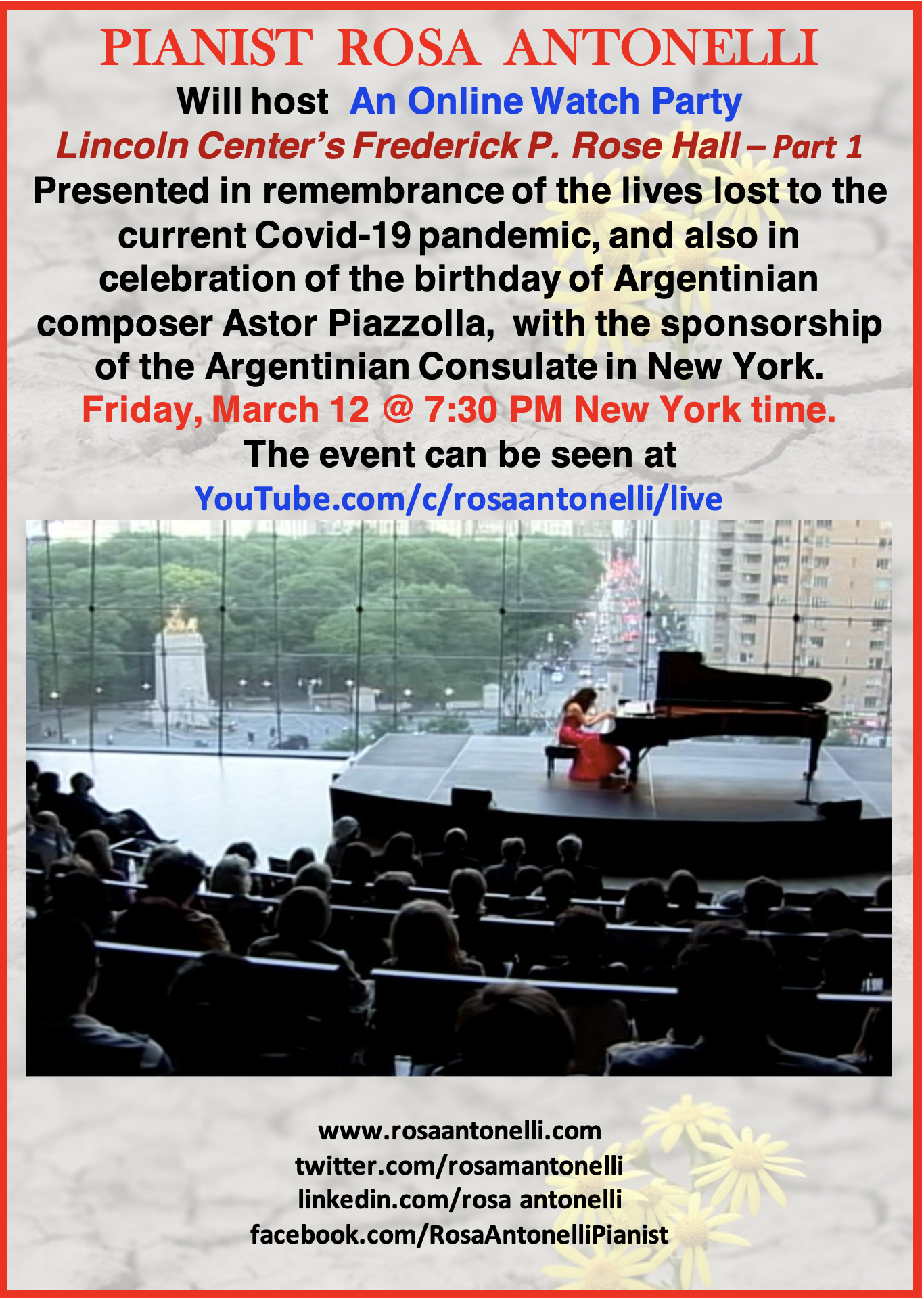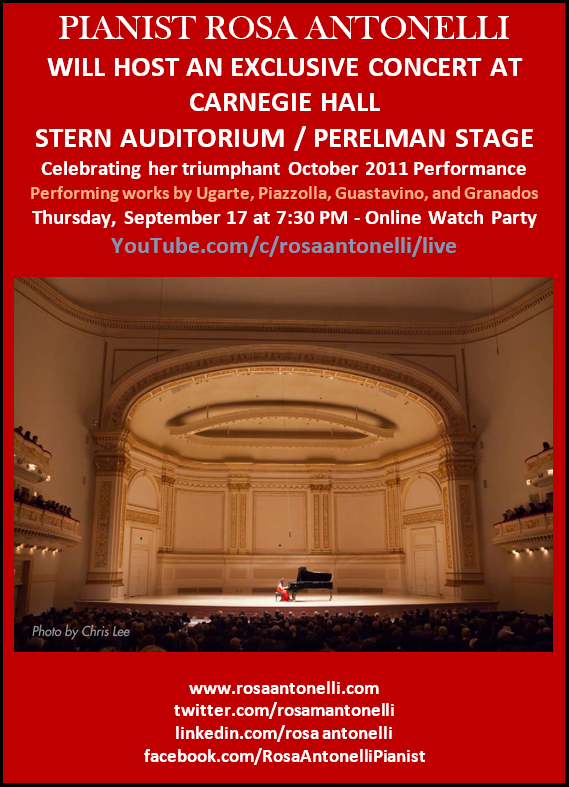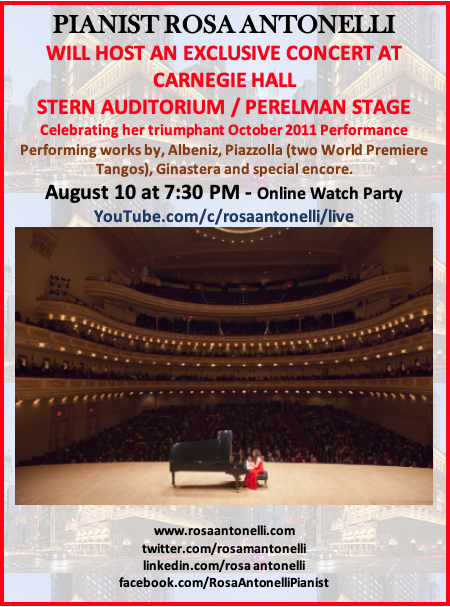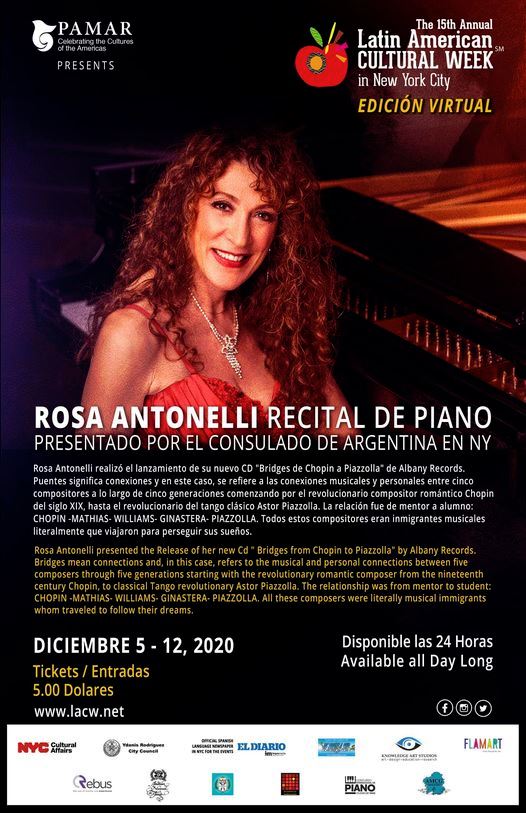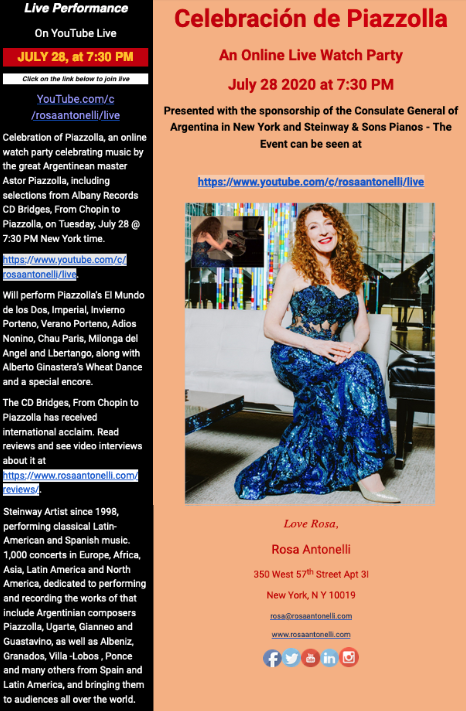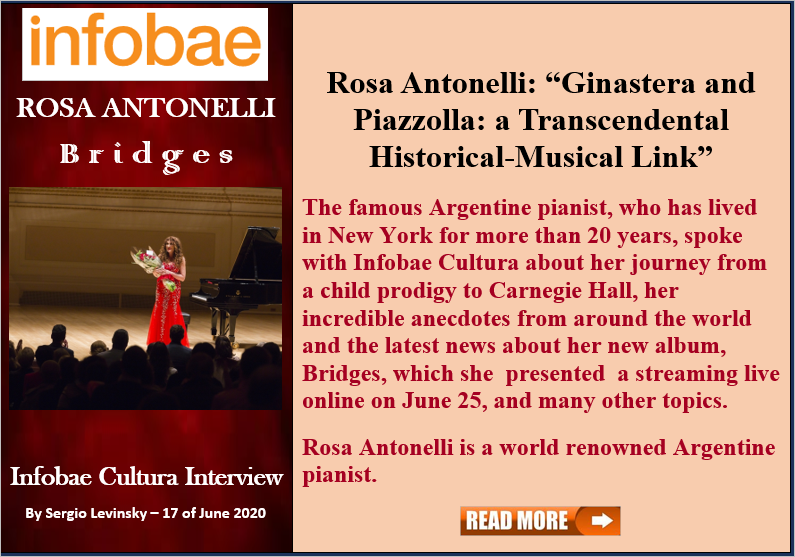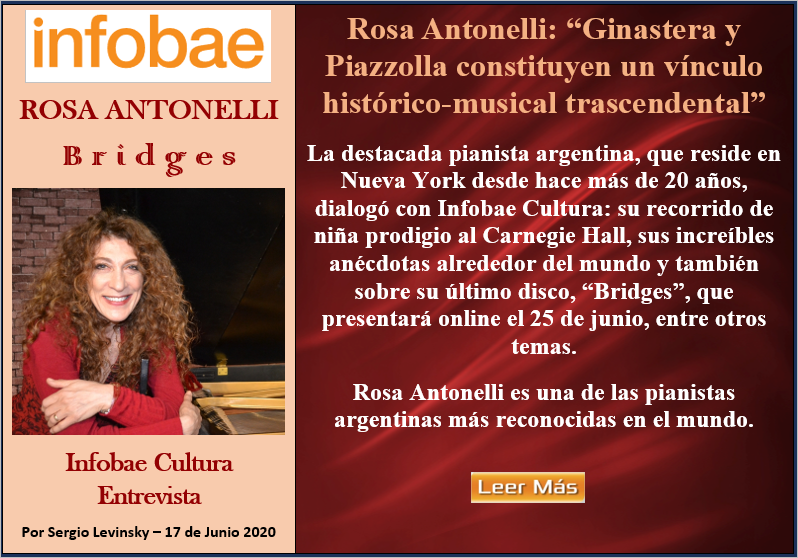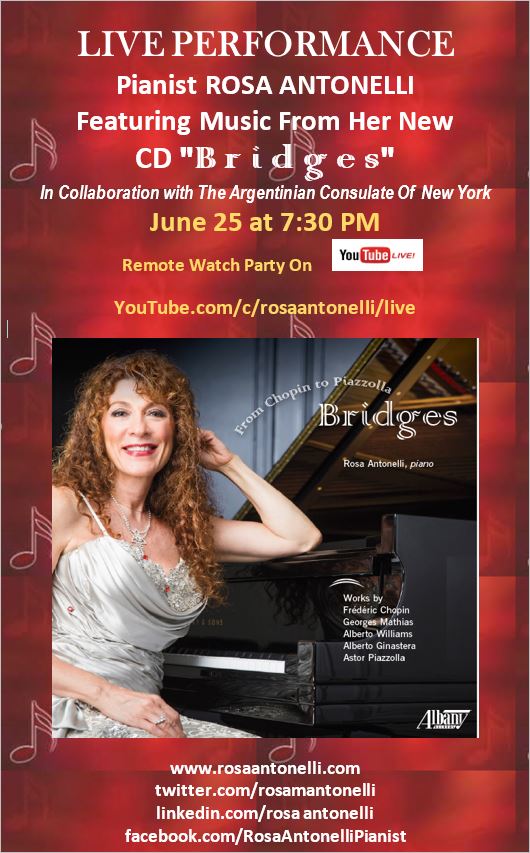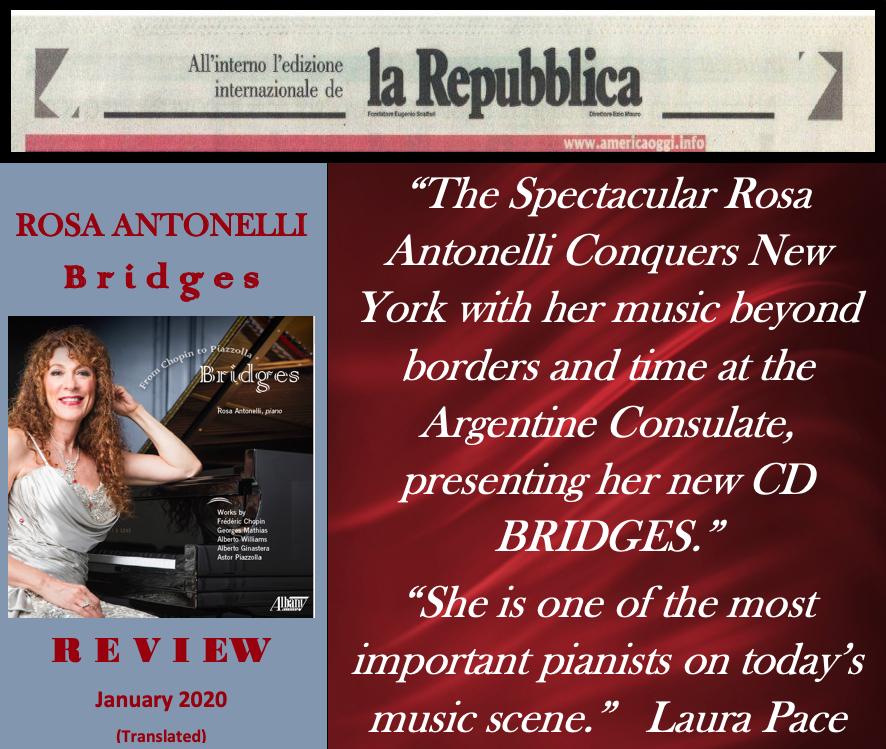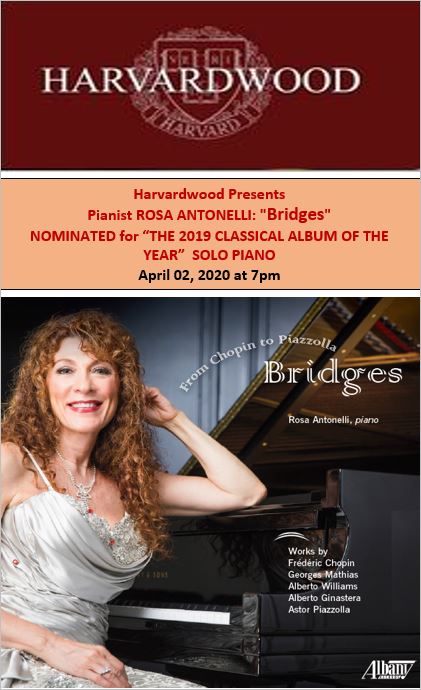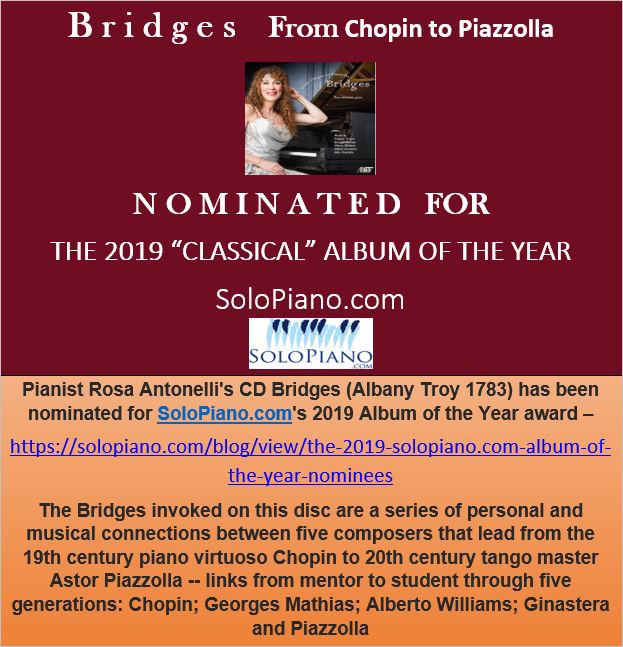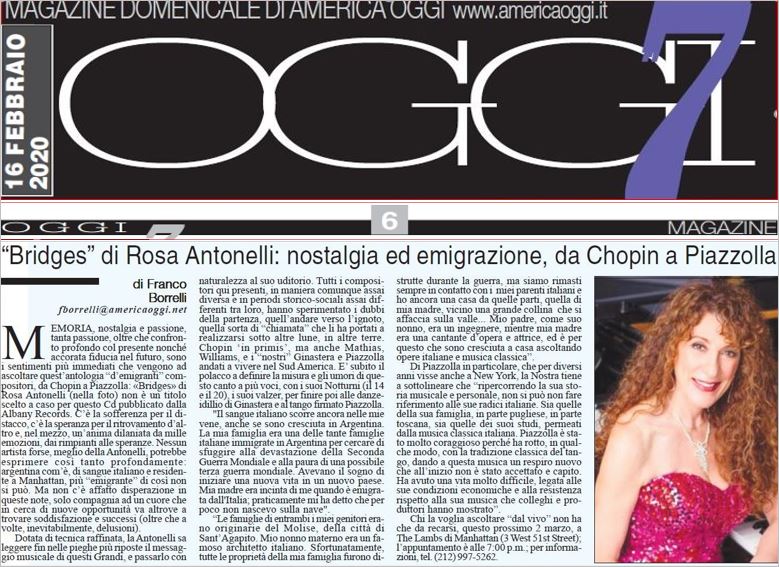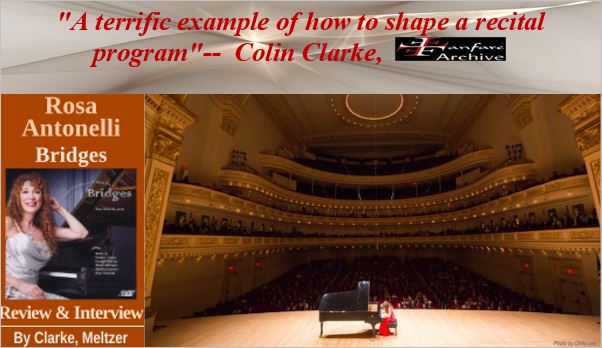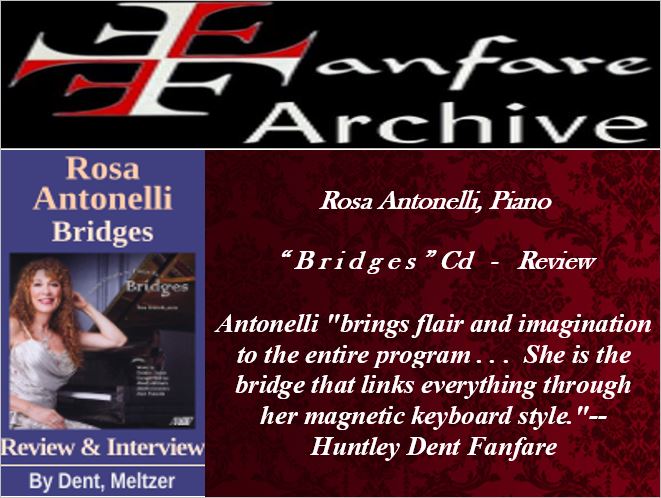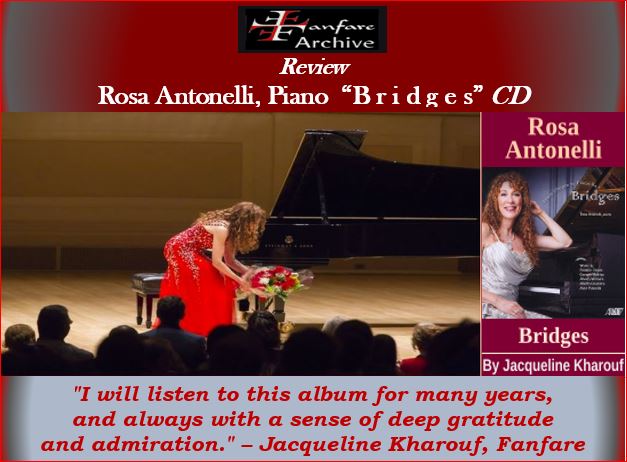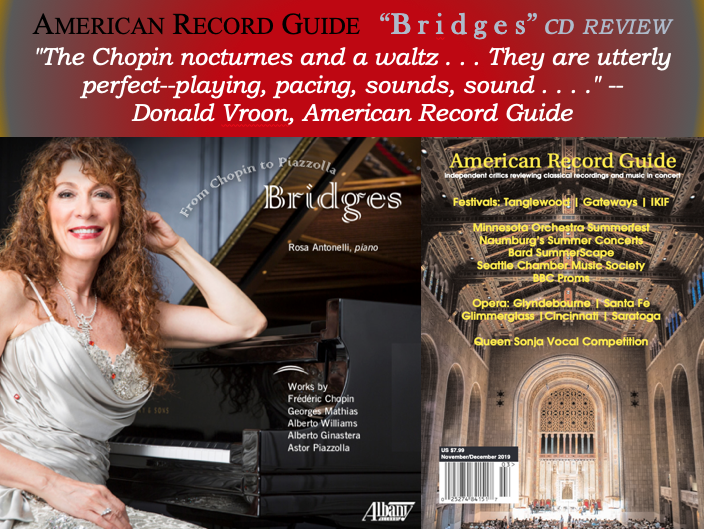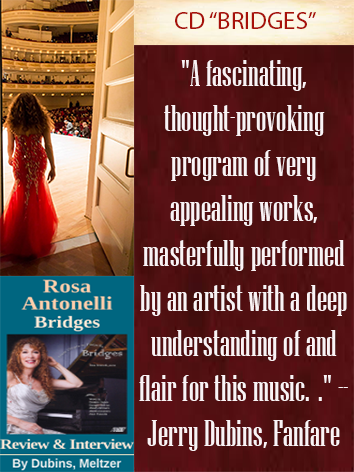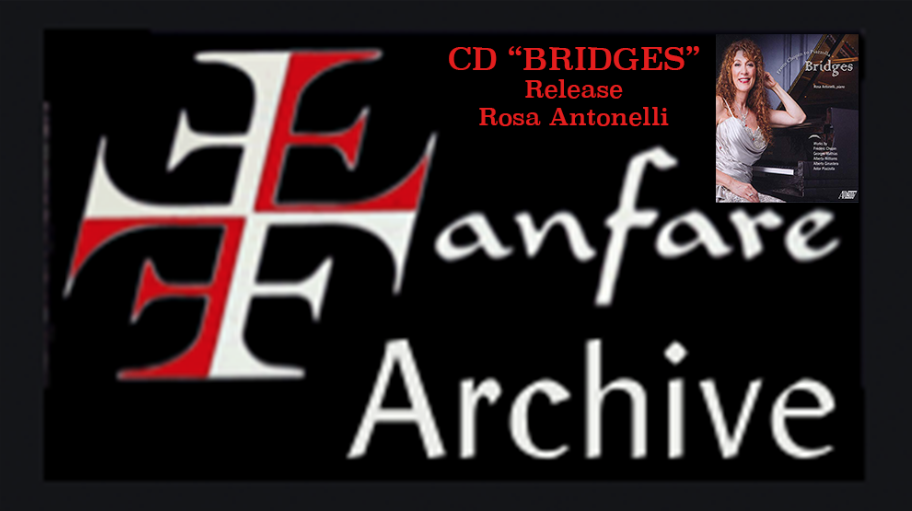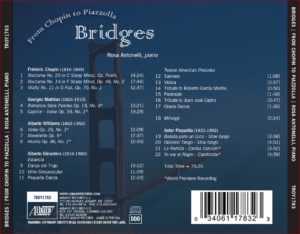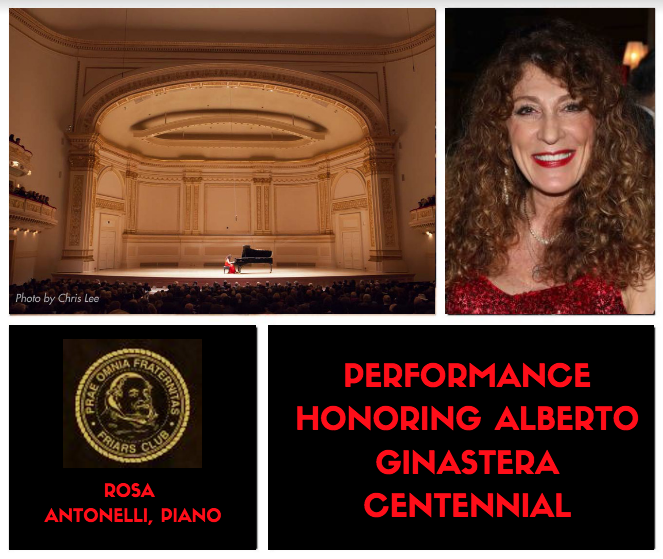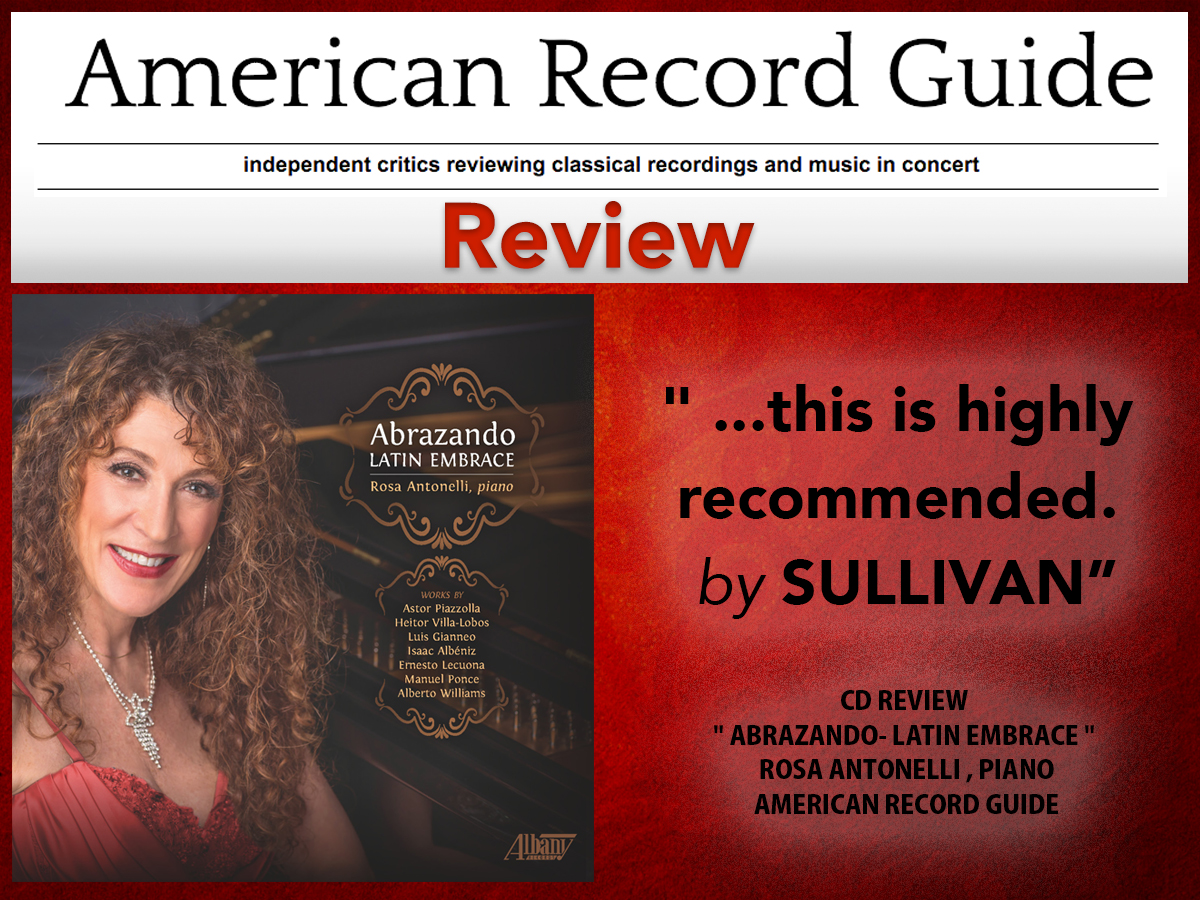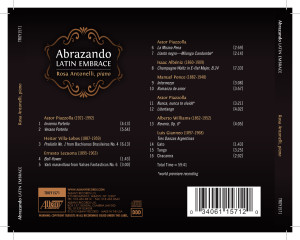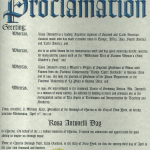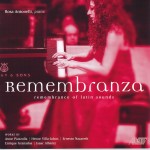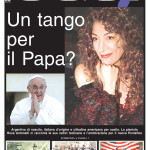INTERNATIONAL WOMEN’S DAY
Dear friends I would like to share with you these beautiful pictures of the Women’s International Day Awards Ceremony in celebration of The International Women’s Day Women from different countries of world were honored by the Society of Foreign Consuls of New York for they are outstanding achievements in their careers and contributions to society. I feel so touched and fulfilled to be recognized as the Woman Representative of the Year of Argentina.
https://youtu.be/6aw9ooqKxX8 (click to watch video)
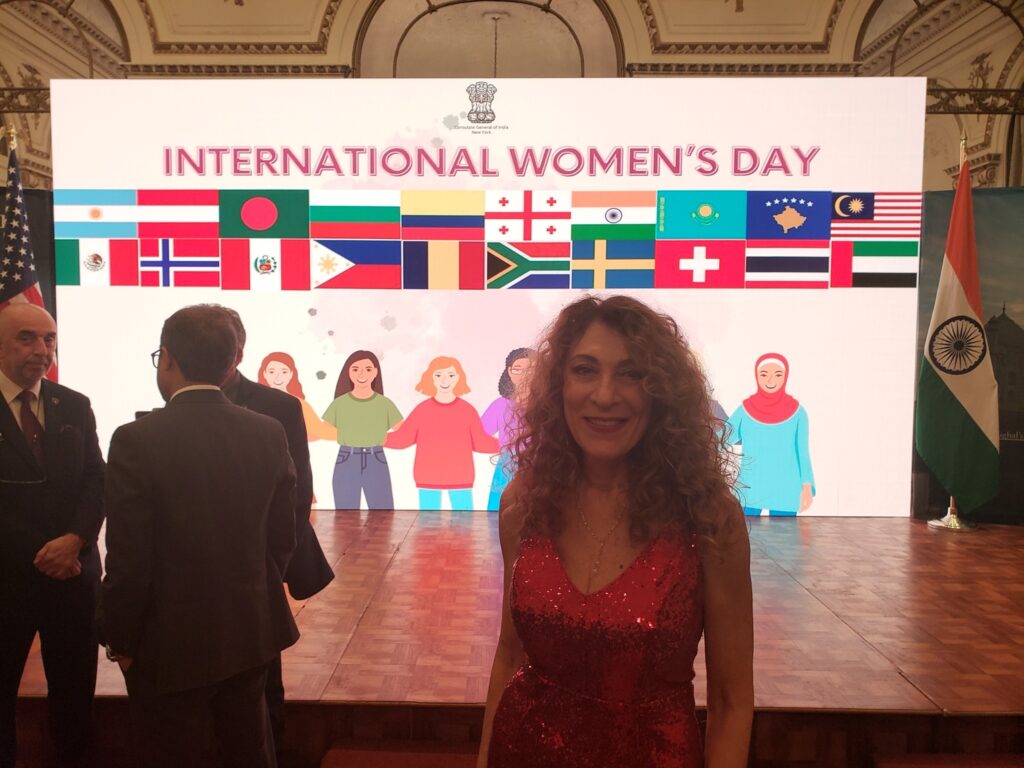
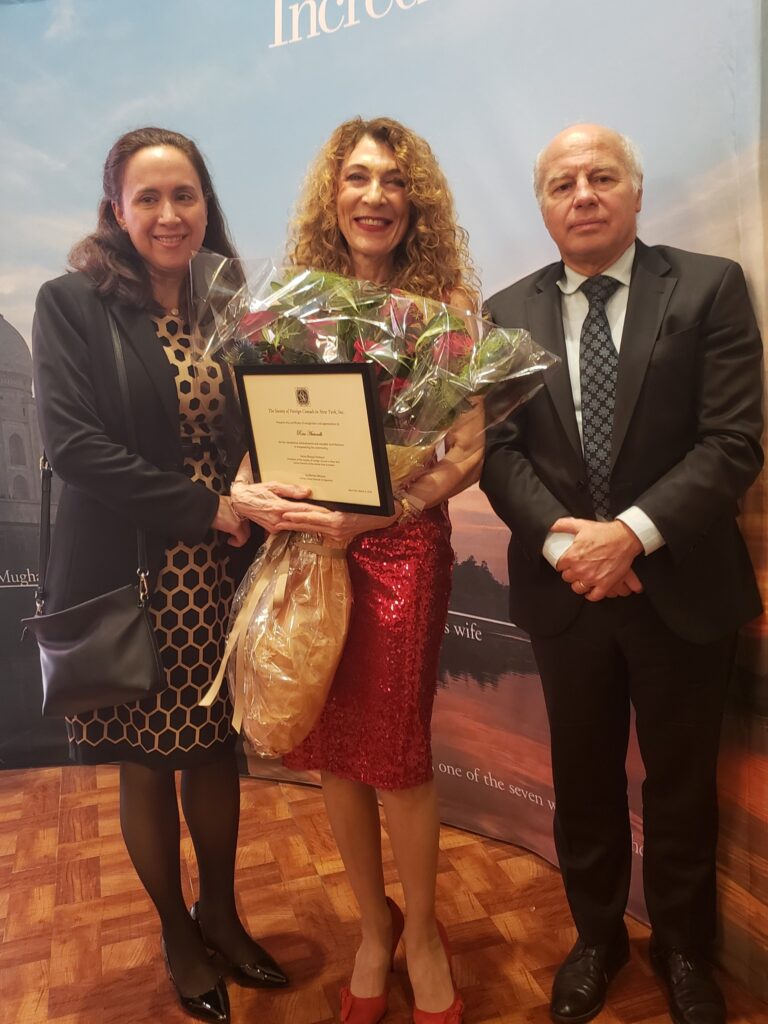
_______________________________________________________
ROSA ANTONELLI
PIANO RECITAL LIVE PERFORMANCE
THE CONSULATE GENERAL OF
ARGENTINA IN NEW YORK
AUDITORIUM OCTOBER 27, 2023

_________________________________________________________________
ROSA ANTONELLI UPCOMING
LIVE PERFORMANCE CONCERT
OCTOBER 27 2023
The Recital program will include pieces by famous Latin American classical composers such as Manuel Ponce(Mexico), Ernesto Lecuoma(Cuba), Heitor Villa-Lobos (Brazil), Pedro Morales Pino (Colombia), Alberto Piazzolla (Argentina)
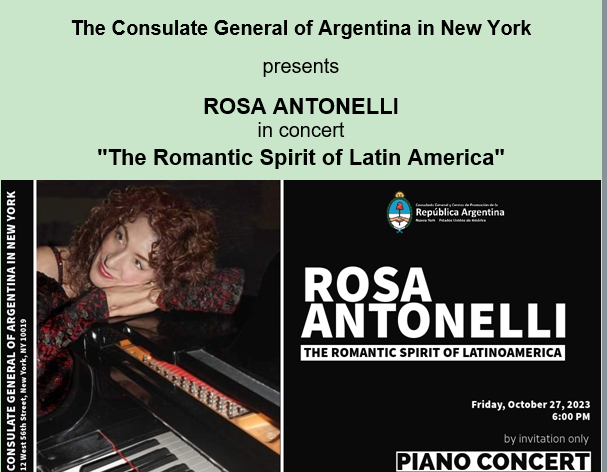
________________________________________________________________________
ROSA ANTONELLI PERFORMANCE –
“The Romantic Spirit of Latin America”
at THE LAMBS in New York City
May 5th 2023
__________________________________________________________
ROSA ANTONELLI – GRANDES PIANISTAS TEATRO MAYOR SANTO DOMINGO, BOGOTA COLOMBIA
Agosto 30 2022 – 8:00 P.M.
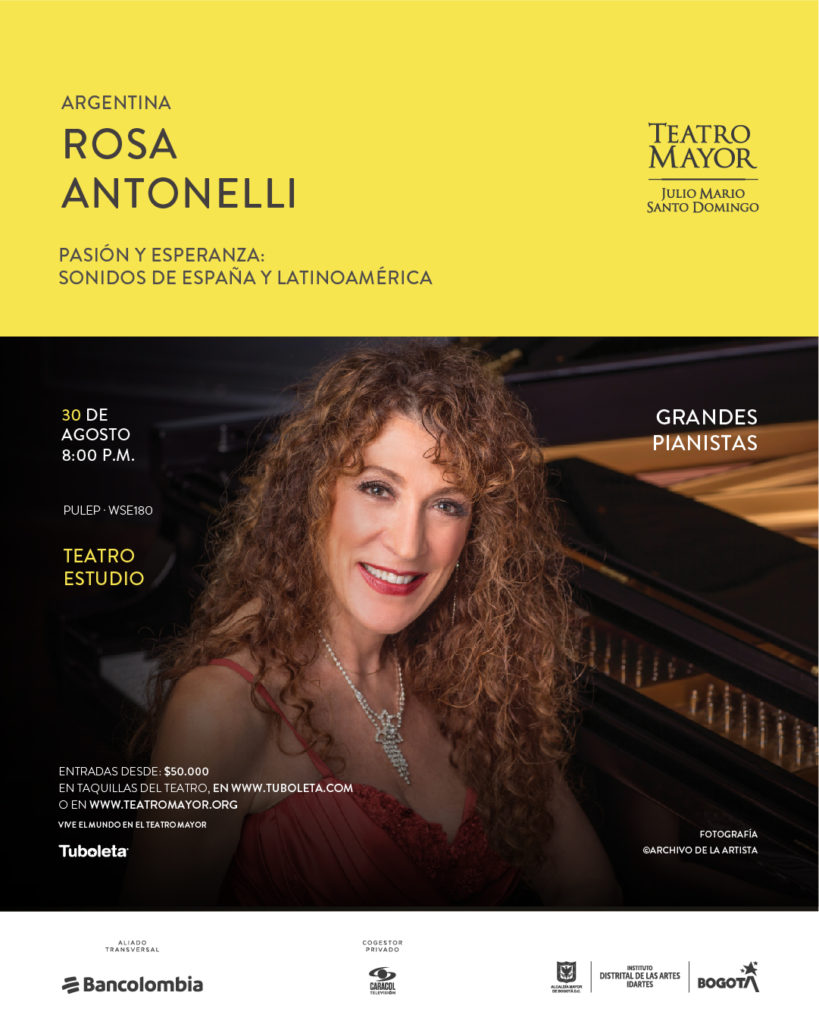

_____________________________________________________
The Lambs Foundation
presents
ROSA ANTONELLI
Tuesday, July 19 2022 – 7 PM
LIMITED SEATING – RESERVATIONS MUST – RSVP BELOW
Donations to The Lambs Foundation accepted at the door
by checks (payable to The Lambs Foundation)
or by PayPal or Venmo. A suggested donation of $10 is appreciated.
RSVP
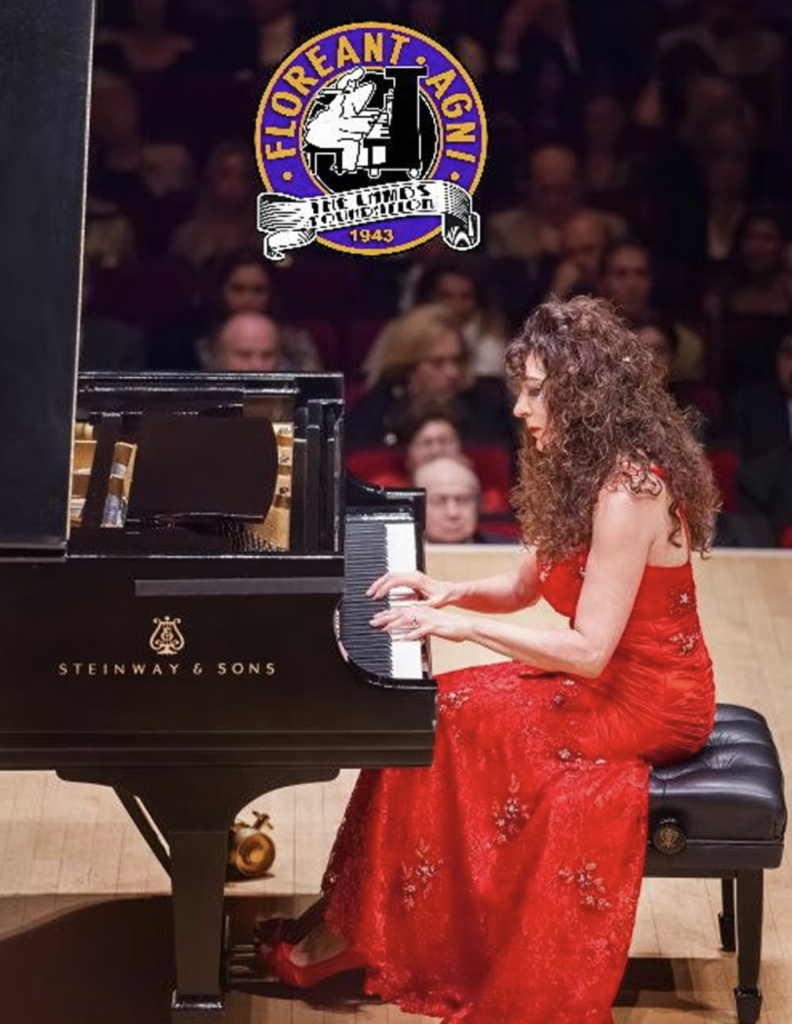
Argentinian pianist Rosa Antonelli, a Steinway Artist since 1998, and a member of The Lambs since 2011, is one of today’s leading performers and a champion of classical Latin-American and Spanish music. She has toured extensively, with more than 1,000 concerts in Europe, Africa, Asia, Latin America, and North America, and is dedicated to performing and recording the works of composers that include Argentinian masters Piazzolla, Ugarte, Gianneo and Guastavino, among others, to audiences all over the world. Rosa previously provided a recital to help The Lambs Foundation raise funds for The Lambs Foundation, and is again offering her talents.
After her initial tour of Europe in 1987, she was invited to tour twenty countries, and has been sponsored by government organizations of many, including the United States, Italy, Germany, Egypt, Argentina, Chile, Colombia, Brazil, and other Latin American countries. She has appeared at concert venues worldwide, including Carnegie Hall and Lincoln Center, Milan’s Palazzo Visconti, Grenoble Auditorium in Naples, Augustinum Theater in Bonn, Madrid’s Ateneo Theater, the Ostrowski Palace in Warsaw, Atrium Theater in Prague, Center Hall of the Glinka Museum in Moscow, Bösendorfer Hall in Vienna, Cairo Opera House in Egypt, Casa de Espana un Utrecht, Maria Calls Hall in Athens, Cristofori Hall in Amsterdam, Colon Theater of Buenos Aires, Bogota’s Teatro Colón, Palacio de Bellas Artes in Mexico City, and Fastlich Auditorium in Tel Aviv. Rosa has performed several times at The Lambs and performed a benefit performance at Steinway Hall with proceeds used to help The Lambs Foundation purchase new pianos. Most recently, Rose gave a recital at the Argentinian Consulate of New York.
Ms. Antonelli has presented lectures and seminars on piano technique and interpretation in various European and Latin American countries. Additionally, she was chairwoman of the Piano Department at the Provincial Conservatory of Music “Alberto Ginastera” and for ten years she was head of the Piano Department. She also held the position of Professor of the Piano Department at the National University of La Plata in Buenos Aires,, and was invited to join the faculty of the Piano University of Adelphi University when she came to the U.S. in 1999. In 2006, the United States honored Rosa by granting her American citizenship because of her government status as “an artists of extraordinary ability.” Her book, Piano: The Spirit of Technique and Interpretation for Teachers and Students, was published in the U.S. in 2013.
April 23rd, 2014, was declared Rosa Antonelli Day in Queens, NY in admiration and appreciation of her ability to inspire people through music.
Marc Baron, President
Copyright © 2022 The Lambs, Inc, All rights reserved.
The Lambs, Inc
3 W 51st St
New York, NY 10019
_____________________________________________________
THE CONSULATE GENERAL of ARGENTINA
PRESENTS – ROSA ANTONELLI IN CONCERT
“SOUNDS OF PASSION AND HOPE “
JUNE 15 2021 at 6 PM
RSVP at rosa@rosaantonelli.com if you are attending

_______________________________________________
Harvardwood Presents: ROSA ANTONELLI Plays Music of Spain and Latin America
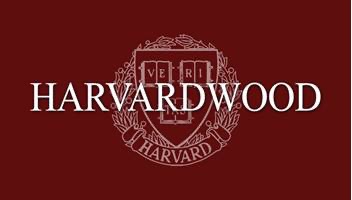
Posted by Spence Porter
WHEN May 25, 2022 at 7:30pm – 9:30pm
WHERE
KLAVIERHAUS
790 11th Ave
New York, NY 10019
United States
Google map and directions
PLEASE SCROLL DOWN PURCHASE TICKETS
In this special concert, the celebrated Argentine pianist Rosa Antonelli will perform piano music by Spanish and Latin American composers, including Ginastera and Piazzolla. Antonelli knew Piazzolla and others of these composers personally, and was entrusted with the world premiere performances of several of Piazzolla’s tangos for piano. She plays this repertory with deep love and a very special warmth and understanding.

When she gave the first of her two solo recitals in Carnegie Hall’s main Stern Auditorium, Joe Franklin wrote, “On October 15 in Carnegie Hall, a star was born. Her name is Rosa Antonelli.” And the legendary critic Harris Goldsmith wrote of her playing, “She is a dyed-in-the-wool Romantic Lyricist. Her always aurally beautiful and caressing pianism uses a lot of color via the sustaining pedal; she molds phrases with enormous flexibility, and there was never a hint of harsh, ugly or astringent glint to her lush singing tone . . . Antonelli’s inward poetry forced me to rehear, and revalue, Piazzolla’s Tangos, which she infused with an eloquence and inner communication.” When her most recent CD, BRIDGES, was released, Jacqueline Kharouf wrote in her review in Fanfare, “I will listen to this album for many years, and always with a sense of deep gratitude and admiration.”
This will be a rare opportunity to hear Rosa Antonelli perform in an intimate 45-seat setting.
If NYC Covid numbers are low enough, a reception with wine will follow the performance.
You must wear a mask and be fully vaccinated against Covid to attend.
Advance registration is REQUIRED. No tickets will be sold at the door.
Special thanks to Andy Goodwin and the Plymouth Hill Foundation.
Register for this event at the link below. Harvardwood members, friends, and non-members are ALL welcome, but every attendee must register for themselves individually. So if you’re inviting others to join you for this panel, please forward them the link to this page so they can sign themselves up. Thank you!
Members, Register Here
Purchase ticket $10.00 Members
If you can’t access the RSVP button for dues-paying Harvardwood members, make
sure you’re logged in. If you still have issues accessing the page, your membership
has lapsed, so renew your dues as a Full Member or Friend of Harvardwood.
NON-MEMBERS please click
Purchase ticket $18.00
Then scrolldown to the “Register Here” Box to pick the number of tickets, then click on the “Purchase ticket“ box and fill out the payment form
No tickets will be sold at the door.
Special thanks to Andy Goodwin and the Plymouth Hill Foundation.
Harvardwood members, friends, and non-members are ALL welcome, but every attendee must register for themselves individually. So if you’re inviting others to join you for this panel, please forward them the link to this page so they can sign themselves up. Thank you!
______________________________________________________________________

Rosa Antonelli from Steinway Hall
in New York
By Juan Carlos Tellechea
Friday, August 20th 2021
Generous, idealistic, romantic, and entrepreneurial as she is, Rosa Antonelli took the initiative to perform this concert to benefit the Lambs Foundation in New York.” Every time I performed at their Auditorium, Steinway & Sons, upon my request, would send me one of their best pianos because the institution’s instrument was not in a perfect condition.” These are memories that the world-renowned pianist evokes and tells us in an exchange in writing and via email with www.mundoclasico.com after its presentation on the internet.
“Until one day – with a firm decision, and without hesitation – I told the president of the Foundation, Marc Baron, why don’t we organize a charity concert: I donate my concert to raise funds and thus have a Steinway piano permanently in the Auditorium. That way all musicians could enjoy it. The idea came from my heart. Baron saw it as challenging because of the amount of money that he would have to raise. Still, then he joined my dreams, my faith … he accepted with great excitement … and that’s where it all began, as the president of The Lambs Foundation himself corroborates at the beginning of the evening prior to the concert on his remarks. “
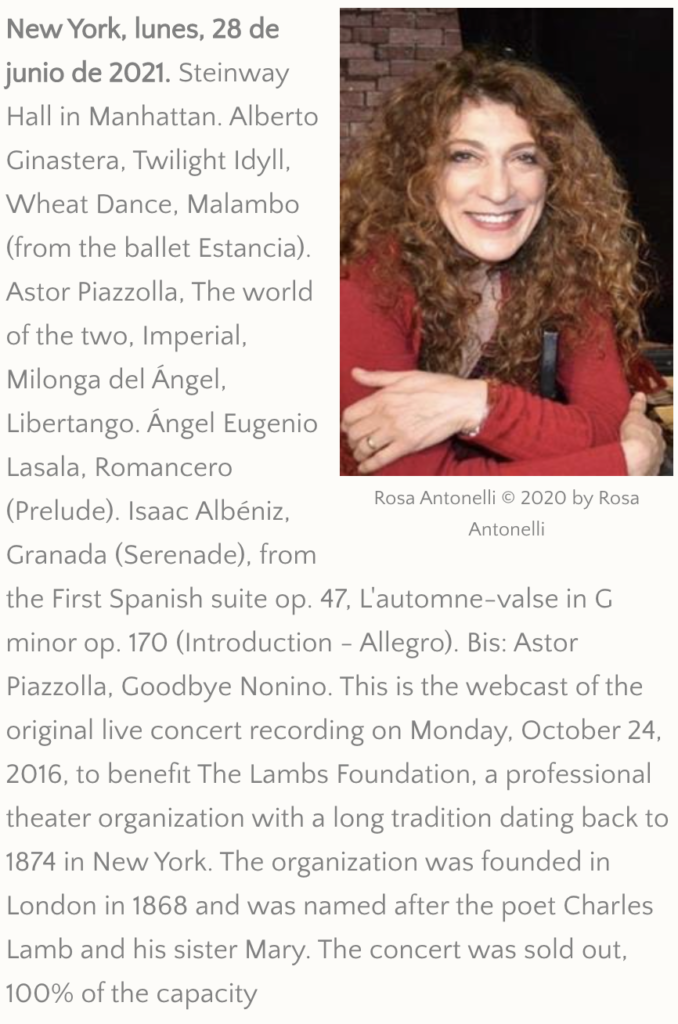
The Lambs Foundation of New York distributes aid to needy, sick, or disadvantaged elderly entertainers. In addition, it supports theater organizations, arts education institutes, and the development of new plays and emerging talent. Through Antonelli’s successful recital that took place on October 24, 2016, with a full house in the Auditorium of Steinway Hall in Manhattan, donations and funds were raised for the purchase of not one, but two pianos: a grand for the Auditorium and another upright one, for the rehearsal room of the respected Foundation. In addition, the recording of that wonderful recital was broadcast for the first time via the internet on June 28.
The Lambs Foundation of New York distributes aid to needy, sick, or disadvantaged elderly entertainers. In addition, it supports theater organizations, arts education institutes, and the development of new plays and emerging talent. Through Antonelli’s successful recital that took place on October 24, 2016, with a full house in the Auditorium of Steinway Hall in Manhattan, donations and funds were raised for the purchase of not one, but two pianos: a grand for the Auditorium and another upright one, for the rehearsal room of the respected Foundation. In addition, the recording of that wonderful recital was broadcast for the first time via the internet on June 28.
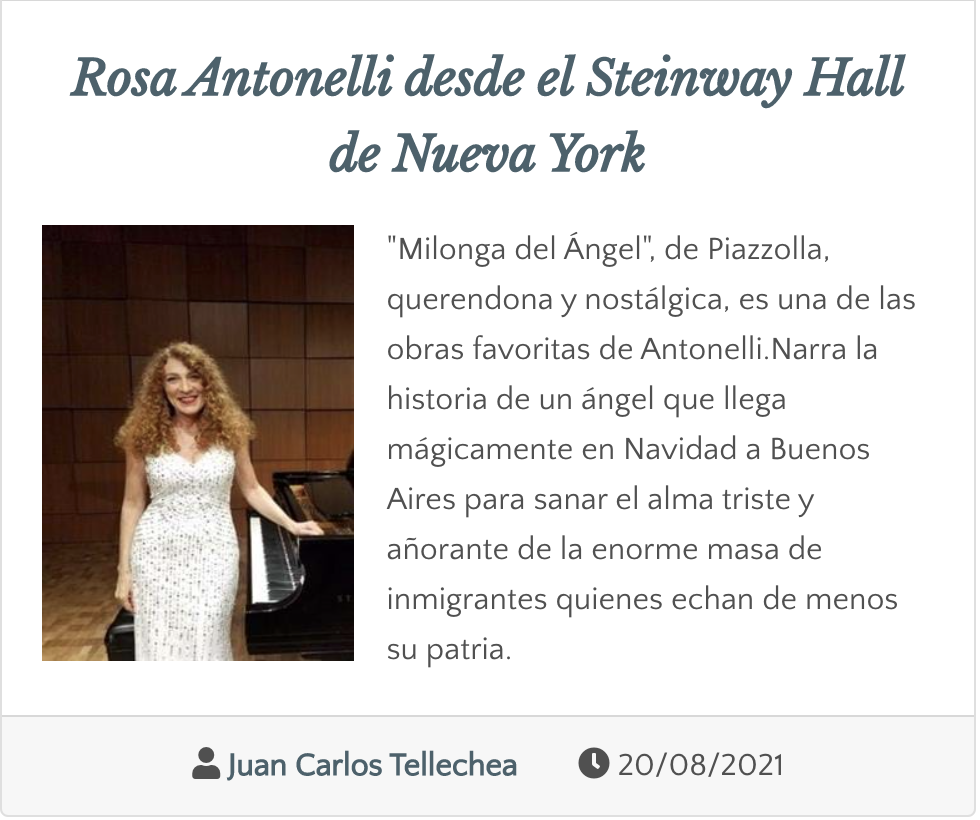
From heart to heart
The exciting and unusual program that Antonelli put together for this evening brought together classic works by composers from the Hispanic and Latin American universe: Ángel Lasala (her admired teacher from the Carlos López Buchardo National Conservatory of Music, in Buenos Aires), Alberto Ginastera, Astor Piazzolla, and Isaac Albéniz. The acclaimed artist has been promoting these beautiful and unique compositions (some of them almost unknown, or played for the first time in New York,) a mission she started since the release of her successful CD Esperanza (Albany Records), followed later by Remembranza, Abrazando and Bridges, the most recent: all from the same record company.
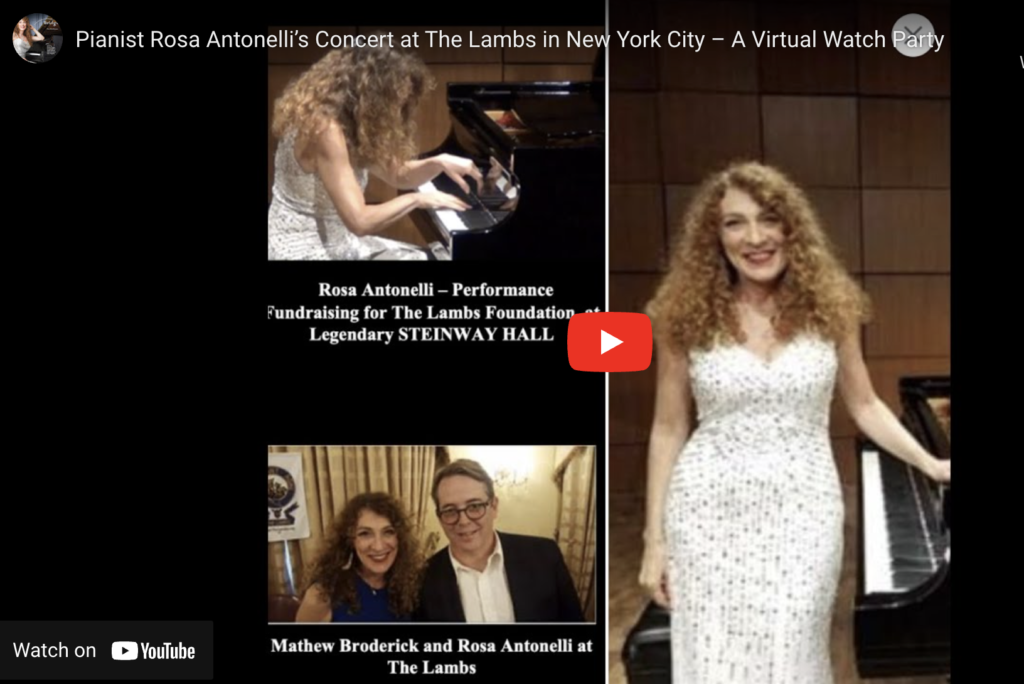
“As it was a charity concert, I felt that I should present works with romantic content or a happy ending, declares Rosa Antonelli (the daughter of a celebrated theatrical actress).” At times, the atmosphere is also meditative but always positive, joyous, which the pianist creates with her interpretations and aura. It is her own heart that opens at the keyboard. The piano is like a sun, full of luminosity as it breathes fresh air and speaks with the radiance in the lights.
Her performance is not only virtuoso, it is pure, clear, transparently honest, clean, precise, and balanced. Each note is played accurately and with a deep meaning. The serenity of her remarkable presence fills the room. She is an imposing figure that magnetizes the audience. Yet It is never an excess in pursuit of spectacularity without a content, a message. Rosa Antonelli masterfully concentrates on the music, from the same profound love for music that she feels right down to her soul and heart.
Love
The recital starts with Twilight Idyll, that romantic piece transcribed from the ballet Estancia, composed initially by Alberto Ginastera to be premiered in 1942 in New York by the American Ballet Caravan, with choreography by George Balanchine. An event that finally could not be. The company was dissolved before, and finally, the work had to wait until 1952 to be presented for the first time at the Teatro Colón in Buenos, under the baton of Juan Emilio Martini and directed by the choreographer Michel Borowski (former member of the Ballets de Monte Carlo who emigrated to Argentina in the late 1940s). A suite for orchestra would meanwhile emerge from Ginastera’s hands. And it became one of his internationally best-known compositions, released in 1943 in Buenos Aires with a success that remains unbroken to this day.
This Idyll tells a romantic story, like Romeo and Juliet or the Beautiful Miller, but with a fortunately happy ending and a reciprocated love: the rancher’s daughter (landowner) falls in love with one of her father’s workers, and the engagement takes place during one of those ineffable sunsets on the pampas plains.
Love is the common thread throughout the recital. Antonelli is punctilious and reveals, pours out a great passion in El Mundo de Los dos, by Astor Piazzolla, a student of Ginastera. This other story was inspired by a perhaps impossible but unforgettable love lived during a summer somewhere on this planet. The poet who wrote the lyrics, Albino Alberto Gómez, 92, a personal friend of Piazzolla, had waited all this time to meet the ideal artist who could interpret the piece. Finally, he decided to personally present the score to Rosa Antonelli in New York after one of her concerts there. “That moment was very moving for me, and I felt very honored by such a memorable gesture”, the pianist evokes.
Mademoiselle
Imperial is a tango written by Piazzolla when he lived in Paris, where he received lessons from the teacher of the great masters, Nadia Boulanger – whom all his students called Mademoiselle – He fell in love with the architecture and palaces of the City of Light, a shared emotion by Antonelli every time she performs there. That same emotional state is the one that exhales Romancero (Prelude) by Ángel Eugenio Lasala. Rosa’s teacher, who knew the sentiment and extreme passion that her student put into her performances, hoped that she would be able to release the composition one day.
That moment came (although posthumously for Lasala, not for his widow, Zulema Castello, who was able to follow the evolution of his dream with great excitement) in 2010 when Antonelli played it for the first time, a World Premiere performance in New York and even on any record company. The day will also come when Argentina writes the complete history of its twentieth-century composers. The work of Ángel Eugenio Lasala must occupy a place of honor with his profile as an authentic creator, notably rooted in Hispanic American culture. For now, it is possible to read his biography on Wikipedia in German, extensively, and in Catalan, in a synthesized way, but no other language … paradoxically!
Albéniz
Through a grant from the government of Spain, Rosa Antonelli specialized in Spanish music at the Música en Compostela International Course, and she delights and gives us the magic of a dazzling performance of Granada (serenade), with impeccable performance virtuosity and expressing it with the soul and spirit of the great teacher Albéniz. It was my first meeting with Spain; a wonderful time remembers the pianist.” I fell in love with the Spanish music, and I felt I didn’t have enough hours to study since I wanted to learn all of his compositions !!. This is how I perfected Granada (serenade).” Antonelli is authentic; she plays how she is deep inside, without pretending. The sound of her soul goes far, far away … levitating
In L’Automne valse (Introduction and Allegro), the result and the message is music in which even the joy and the tone are affected by the melancholy that the composer feels towards his homeland, essentially fantastic. Antonelli’s performance has a rare elegance and mystery, of astonishing and great sensibility; a true, genuine, authentic, and well-controlled Hispanic culture, feelings, and roots, admirable in its original purity. I studied this work in Madrid.” To my great surprise, this waltz had never been played in New York in a large concert hall, and its premiere took place when I performed it at Lincoln Center, Antonelli recounts.
Immigration
Milonga del Ángel, by Piazzolla, querendona and nostalgic, is one of the pianist’s favorite works. It tells the story of an angel who magically arrives in Buenos Aires at Christmas to heal the sad and longing soul of the vast, enormous mass of immigrants (or their descendants) who miss their homeland. It is the melancholy that they have ingrained, printed in their hearts due to the distance and separation from their loved ones, something that I, myself, have experienced in my family; it is a beautiful and romantic story, says Antonelli. Hand in hand with her, Piazzolla reveals those enigmatic regions that characterize the atmosphere of the elusive and busy Buenos Aires capital, taking us further and further into remote and unlikely labyrinths.
Final
The pianist , turns her gaze and heart at the end of her concert to Ginastera and again ,to the Estancia ballet originally commissioned to this composer by the businessman, writer, connoisseur of New York art circles, and philanthropist Lincoln Kirstein in 1941. The music is full of vital energy. The Wheat Dance is more restrained in terms of rhythm and melancholy. Antonelli literally approaches, touches the keyboard with great sensitivity to deliver this most beautiful, lyrical, and serene piece. The estancia (ranch) workers ,work in the wheat field since the dawn of the morning. With its diverse coloring, the music reflects the daylight as the sun changes position in the sky, a wonderful setting in the middle of which the farmworker and the owner’s daughter met and felt in love .
The Malambo
The final dance, a malambo, is a swirling, agitated, feverish, and devilish movement and that nothing seems to stop when it emanates from the piano. Their frenzied tapping and stomping make this brilliant and passionate dance a perfect work to reach the climax of this extraordinary and exceptional Rosa Antonelli’s concert with joy and uplifting spirit. But, of course, the recital could not end here, amid and surrounding with so many applause and ovations. The audience insistently asked for Goodbye Nonino by Piazzolla. The soloist performed the elegiac piece with great love and tenderness, which recalls the beautiful, close relationship that united the creator of the new tango with his father, Don Vicente, his death, and the evocation and memories of the happy moments they spent together.
Let’s build a better world
It was a very emotional closing of Rosa Antonelli’s performance, a pianist, adored by the public and now awaited with expectation again in Europe.
“This concert was very special for me, because I felt very honored to help this noble and venerable Foundation. I was filled with happiness knowing that a dream had come true; a dream that was born out of hope, passion and love for ideals. In these difficult times, we must keep these positive feelings in our hearts that will help all of us be stronger and build a better world together.”
” COMING SOON ”
LIVE ONLINE WATCH PARTY CONCERT
Wednesday, July 28, 2021 at 7:30 PM
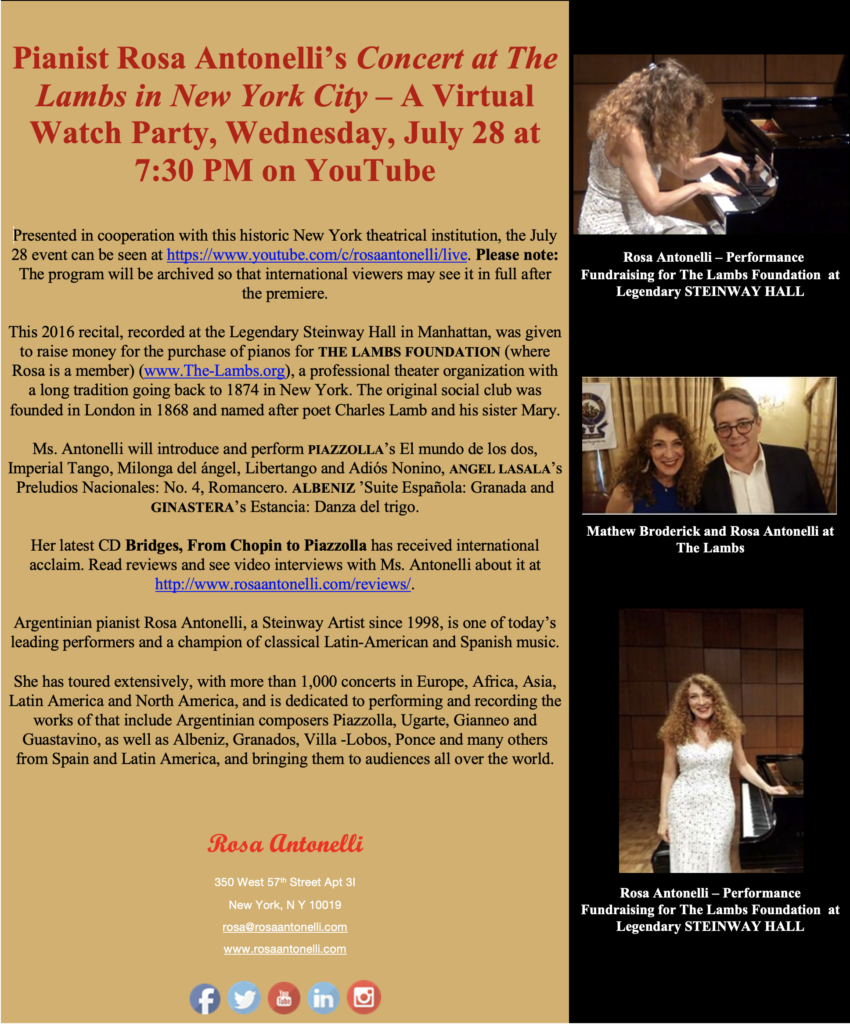
Missed the event ? – Watch Video here 
LIVE ONLINE WATCH PARTY CONCERT 2nd part
SPONSORED BY THE ARGENTINIAN CONSULATE IN NEW YORK
LIVE ONLINE WATCH PARTY CONCERT
SPONSORED BY THE ARGENTINIAN CONSULATE IN NEW YORK
Rosa Antonelli – Live Performance Concert
Online Watch Party From The Legendary
CARNEGIE HALL in New York City (PART 2)
Missed the event ? – Watch Video here 
Rosa Antonelli – Live Performance Concert
Online Watch Party From The Legendary
CARNEGIE HALL in New York City
CONCERT AT THE CONSULATE OF ARGENTINA IN NEW YORK
Presented the music of my Latest CD BRIDGES, from Chopin to Piazzolla. If you didn’t have the chance to see it, you still have time till December 12!
Missed the event ? – Watch Video here 
I N F O B A E INTERVIEW – JUNE 2020
LIVE HOME PERFORMANCE CONCERT
IN COLLABORATION WITH THE ARGENTINIAN CONSULATE OF NEW YORK
Missed the event ? – Watch Video here 
Harvardwood Presents Pianist ROSA ANTONELLI: “Bridges”
NOMINATED for “THE 2019 CLASSICAL ALBUM OF THE YEAR” SOLO PIANO
April 02, 2020 at 7pm
Rosa Antonelli, one of Argentina’s leading pianists, is especially celebrated for her performances of the classical piano music of Latin America. Antonelli knew Piazzolla and others of these composers personally, and she plays this repertory with deep love and a very special warmth and understanding.
When she gave the first of her two solo recitals in Carnegie Hall’s main Stern Auditorium, Joe Franklin wrote, “On October 15 in Carnegie Hall, a star was born. Her name is Rosa Antonelli.” And the legendary critic Harris Goldsmith wrote of her playing, “She is a dyed-in-the-wool Romantic Lyricist. Her always aurally beautiful and caressing pianism uses a lot of color via the sustaining pedal; she molds phrases with enormous flexibility, and there was never a hint of harsh, ugly or astringent glint to her lush singing tone . . . Antonelli’s inward poetry forced me to rehear, and revalue, Piazzolla’s Tangos, which she infused with an eloquence and inner communication.” Donald Vroon of American Record Guide has called Antonelli’s Chopin playing “Utterly perfect—playing, pacing, sounds.”
This special private invitation-only concert for Harvardwood members and friends celebrates the release of Antonelli’s new CD, BRIDGES. Chopin was the teacher of Georges Mathias, who was the teacher of Alberto Williams, who taught the great Argentine composer Alberto Ginastera, who in turn was the teacher of Astor Piazzolla, and in BRIDGES Antonelli plays the music of each of these, making the chain of connection one that can be experienced through the music itself. Jacqueline Kharouf wrote in her review in Fanfare, “I will listen to this album for many years, and always with a sense of deep gratitude and admiration.”
For this concert, Rosa Antonelli’s program will include music by Chopin and Piazzolla and others.
________________________________________
BRIDGES From Chopin to Piazzolla
AMERICA OGGI ITALIAN MAGAZINE ARTICLES
(English Translation below each article picture)
“Bridges” by Rosa Antonelli: nostalgia and emigration, from Chopin to Piazzolla , by Franco Borrelli
MEMORY, nostalgia and passion, a lot of passion, as well as comparison deep in the present as well heartfelt trust in the future, I am the most immediate feelings that come to listen to this anthology of “emigrant” composers, from Chopin to Piazzolla: «Bridges» by Rosa Antonelli (pictured) is not a title randomly chosen for this CD published by Albany Records. There is suffering from detachment, there is hope for finding another and, in the middle, a soul torn apart by a thousand emotions, from regrets to hopes. No artist perhaps, better than Antonelli, could express so deeply: Argentina as it is, of Italian blood and resident in Manhattan, more “emigrant” than not you can. But there is no despair at all these notes, only company to a heart that looking for new opportunities goes elsewhere a find satisfaction and success (as well as a sometimes, inevitably, disappointments). Equipped with refined technique, Antonelli knows read the message even in the most hidden folds musical of these Great, and pass it with naturalness to his audience. All composers here present, however very different and in very different historical and social periods among them, they experienced doubts of departure, that going into the unknown, that sort of “call” that led them to come true under other moons, in other lands. Chopin ‘in the first place’, but also Mathias, Williams, and “our” Ginastera and Piazzolla went to live in South America. It is immediately on Polish to define the extent and moods of this I sing in several voices, with its Nocturnes (the 14 and on the 20th), his waltzes, to end then at the dancesidillio of Ginastera and tango by Piazzolla. “Italian blood still flows into mine veins, although I grew up in Argentina. My family was one of many families Italian immigrants to Argentina to try to escape the devastation of the Second World War and fear of a possible third World war. They had the dream of start a new life in a new country. My mother was pregnant with me when she emigrated from Italy; pretty much told me that for little was not born on the ship. ” “Both my parents’ families were originating from Molise, from the city of Sant’Agapito. My maternal grandfather was a famous one Italian architect. Unluckily, all the properties of my family were destroyed during the war, but we stayed always in contact with my Italian relatives and I still have a house over there, that of my mother, near a big hill that is overlooking the valley … My father, like his grandfather, he was an engineer while my mother she was an opera singer and actress, and it is for this that I grew up at home listening to Italian operas and classical music “. Di Piazzolla in particular, which for several years also lived in New York, Our holds to underline that “retracing its history musical and personal, you can’t help it reference to its Italian roots. Be those of his family, partly from Puglia, partly Tuscan, both those of his studies, permeated from Italian classical music. Piazzolla was very brave because he broke, in some way, with the classic tradition of tango, giving this music a new breath which was not initially accepted and understood. He had a very difficult life, linked to its economic conditions and resistance compared to his music that colleagues and producers they showed”. Who wants to listen to it “live” does not have that to go, this March 2, to The Lambs of Manhattan (3 West 51st Street); the appointment is at 7:00 p.m .; for information, tel. (212) 997-5262.
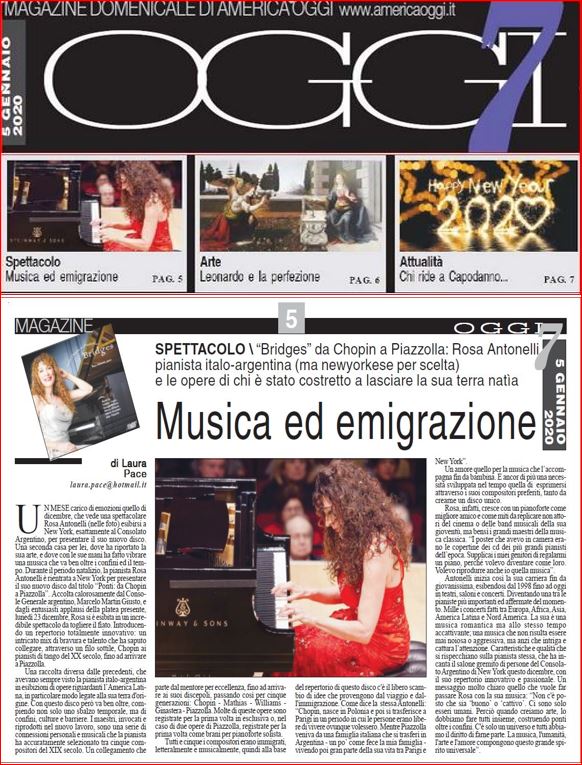 Rosa Antonelli Conquers New York with Her Music Beyond Borders
Rosa Antonelli Conquers New York with Her Music Beyond Borders
Abstract: December was a month full of emotions, which saw the spectacular Rosa Antonelli performing in New York at the Argentine Consulate, presenting her new album. (This is) A second home for her, where she brought her art, and where her hands made vibrant music that went far beyond borders and time.
During the Christmas season, the pianist Rosa Antonelli returned to New York to present her new album entitled “Bridges: from Chopin to Piazzolla” (Albany Records – Troy 1783). Warmly welcomed by the Argentine Consul General and a large audience, on Monday 23 December, Rosa performed an incredible, breathtaking show.
(She) presented a totally innovative repertoire that starts from Chopin (and goes) up to the twentieth century tango composers like Piazzolla – a collection different from the previous ones, which had always seen the Italian-Argentine pianist in performances of works concerning Latin America, especially her homeland. This time, however, it went further, totally changed, making not only a temporal change, but of borders, cultures and barriers.
The masters invoked and reproduced on this disc are a series of personal and musical connections that the pianist has carefully selected from five 19th century composers. A connection that starts from the mentor par excellence to his disciples, passing through five generations: Chopin – Mathias – Williams – Ginastera – Piazzolla. Many of these works are recorded Premieres, in the case of two works by Piazzolla, recorded for the first time as pieces for solo piano.
All five composers were immigrants, literally and musically, so the basis of the repertoire of this record is the free exchange of ideas that come from travel and immigration. As Antonelli herself says: “Chopin, was born in Poland, then moved to Paris in a period in which people were free to live wherever their hearts took them, while Piazzolla came from an Italian family who moved to Argentina, a bit like my family did, then living most of his life between Paris and New York.”
A love for music and for these artists that has accompanied her since she was a child. A need to express oneself through these (was) enough to create a record. Indeed, Rosa grew up with a piano as a best friend and with the myths to be replicated by the great masters of classical music, not film or of the musical bands of her youth. (She says,) “The posters I had in my room were the covers of the CDs of the greatest pianists of the time. I begged my parents to give me a plan, because I wanted to become like them too. I also wanted to reproduce that music.”
Thus Antonelli began her career from a very young age, performing from 1998 until today; becoming one of the most important pianists on today’s music scene, performing (more than) a thousand concerts in Europe, Africa, Asia, Latin America and North America.
Her music is romantic but at the same time captivating; a music that never turns out to be boring or aggressive but rather that intrigues and captures attention – characteristics and qualities that are reflected on the pianist herself, who enchanted the whole audience of the Argentine Consulate in New York with her innovative and passionate repertoire.
A very clear message what Rosa wants to pass with her music: “There is no place that is “good” or “bad”. There are only humans. So when we create art, we have to do it all together, building bridges across borders. There is only one universe and we all have the right to be part of it. Music, humanity, art and love make up this great universal spirit.”
Laura Pace
CD “B R I D G E S” Interview with Pianist Rosa Antonelli By Ken Meltzer – Fanfare Magazine
In Bridges, a new CD on the Albany label, pianist Rosa Antonelli traces a direct lineage from the great 19th-century pianist and composer, Frédéric Chopin, to the 20th century bandoneón virtuoso and father of the Nuevo Tango, Astor Piazzolla. I spoke with Rosa Antonelli about the recording, and the many kinds of bridges it contemplates.
The title of your new recital on the Albany label is Bridges. In the introductory comments to the recording, you note that several types of bridges are represented, both by the composers and repertoire you chose, and by your own life and career. ![]()
NEW CD
“BRIDGES from Chopin to Piazzolla”
CD Release by Albany Records
It is available on www.amazon.com www.albanyrecords.com www.arkivmusic.com and iTunes.
I invite you to discover it for yourself.
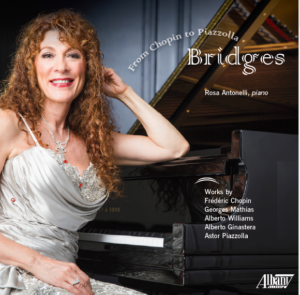
This program has been selected by Rosa Antonelli, a pianist who has championed repertoire from Latin America, particularly from her homeland of Argentina — often resurrecting little-known jewels. Antonelli, a Steinway Artist since 1998, is one of today’s leading performers, who has toured extensively, with more than 1,000 concerts in Europe, Africa, Asia, Latin America, and North America to her credit. Her three previous recordings on Albany Records have received rave reviews from critics.
The Music
Bridges, whether physical or metaphorical, are first and foremost connections: bring-ing together people on two sides of a river, two sides of an issue, or differing political or religious views. The bridges invoked on this disc are a series of personal and musical connections between five composers that lead from the 19th-century piano virtuoso Chopin to 20th-century tango master Piazzolla—links from mentor to student through five generations: Chopin – Mathias – Williams – Ginastera – Piazzolla.
Rosa Antonelli described the origins of this concept: “It all started at my last concert at Carnegie Hall when Susan Bush, president of Albany Records, who was in the audience, came backstage after the recital and said, ‘When you played Chopin as an encore, I heard Piazzolla’s music—it’s all romantic!’ I heard similar comments from others in the audience, and I’ve felt the same for many years.”
The program begins in 19th-century France with romantic works by Chopin and his student Mathias, and concludes with works by Argentina’s great 20th-century composer Ginastera, and his student Piazzolla. The keystone of this arch is Alberto Williams, one of the founders of Argentine classical music at the turn of the 20th century. Williams traveled to Paris as a young man, training with Mathias, and had a profound influence on the next generation of Argentine composers, including Ginastera. Chopin and Piazzolla might seem to be from two different musical worlds, but listening to this collection as a set, you will be struck by the connections across the generations as two gradual evolutions take place. The first of these is the evolution of style from Chopin’s romanticism through Ginastera’s aggressive modernism, to the more eclectic music of Piazzolla. The second is the gradually more confident adoption of Argentine idioms through the works of Williams, Ginastera, and Piazzolla. There is also a sense in this repertoire of coming full circle: Piazzolla works like Oblivion and La Partida are every bit as “romantic” in conception (if not in musical style) as a Chopin nocturne.
All five composers were immigrants, literally and/or musically, so underlying the repertoire on this disc is the free exchange of ideas that come from travel and immigra-tion. As Ms. Antonelli put it: “Chopin, born in Poland, moved to Paris in a day when people were free to live wherever their hearts led them, and Piazzolla, whose family came from Italy to Argentina (as did my family) lived important parts of his life in Paris and New York. There is no place that is ‘good’ or ‘bad.’ There are only human beings, and when we create art, we all do it together, building bridges across borders. There is just one universe, and we all have our part of it. Music and humanity and art and love are all parts of the same universal spirit.”
This program has been selected by Antonelli, a pianist who has championed repertoire from Latin America, particularly from her homeland of Argentina—often resurrecting little-known jewels. As on her previous Albany release (Abrazando – Latin Embrace, 2015), several of these works are recorded for the first time, or—in the case of two Piazzolla works—recorded for the first time as solo piano pieces.
FRÉDÉRIC CHOPIN (1810-1849)
Nocturne No.20 in C-sharp minor, Op. Posth. | Nocturne No. 14 in F-sharp minor, Op. 48, No. 2 | Waltz in G-flat Major, Op. 70, No. 1
The Polish virtuoso Chopin enjoyed some early success in his homeland before embarking on a European tour at age 20. He started in Vienna and after performing in several countries he decided to settle in Paris in 1832, where he also enjoyed great success as a piano teacher. Chopin performed only a few times each year, usually in the intimate setting of Parisian salóns and invitation-only gatherings in his own apartment—venues perfectly suited to his often introspective and subtle piano works.
Chopin did not invent the piano nocturne, a genre evoking a quiet nighttime mood in a single movement, but it was Chopin’s 21 nocturnes that refined the form, and which were most widely emulated by later composers. This disc begins with his Nocturne No. 20. Though was not published until well after his death, No. 20 is in fact one of his earliest essays in the form, composed in around 1830. Its main section features a serious melody that springs out of a solemn six-note motive at the opening. The contrasting middle section is a brighter, major-key idea. No. 14 is the second of two nocturnes published in 1842 as his Op. 48, with a dedication to his student Laure Duperré. Its main section is uncharacteristically agitated, with a sometimes chromatic theme played above unexpected shifts in harmony. The sober middle episode proceeds from a series of broad chords and melodic flourishes, and in the restatement of the main idea there is an emotional break in the texture before the piece ends with quiet trills and a striking flourish.
The waltz took Europe by storm in the early 19th century, and Chopin was one of many composers who adapted the form. The G-flat Major waltz that concludes this set was composed between 1829-32, and was published posthumously. Its outer sections have a swirling, wide-ranging melody, while its middle is calmer and more reserved.
GEORGES MATHIAS (1826-1910)
Romance Sans Paroles, Op. 18, No. 4 | Caprice-Valse, Op. 38, No. 1
Mathias, born in Paris to a family of German and Polish immigrants, trained at the Paris Conservatoire, but also took private lessons from Chopin for five years. Chopin’s music would remain the strongest influence on his compositions. Decades later, in a memoir published after his death, he said that Chopin was “so sensitively organized that, like the X-rays, he saw a thousand things where others see only one.” Mathias had a successful career as a soloist, and was a prolific composer, but his broad-est influence was as a teacher—he spent over 30 years as a piano teacher at the Conservatoire, where he attracted an international group of students from Europe and the Americas, including two notable South American musicians: the Venezuelan phe-nomenon Teresa Carreño and Argentine pianist-composer Alberto Williams.
In the 1850s Mathias published a set of Romances Sans Paroles, Op.18 (Songs Without Words). Like the nocturne, this genre seems to have its roots in the music of Englishman John Field, though the form was refined by Mendelssohn in the 1830s. The Romance Op. 18, No. 4 by Mathias clearly bears the imprint of Chopin’s lyrical style. It has a simple three-part form, with statements of a main idea surrounding a slightly more melancholy middle section, before ending with a sentimental postlude.
The Caprice-Valse, Op.38 was one of three Morceaux de Concert Mathias published in about 1865. This is an extended series of musical sections that have a family resemblance to Chopin’s waltzes, though Mathias introduces rather gentle chromati-cism, and some adventuresome modulations in the middle of the piece, before return-ing to a few main ideas at the end.
ALBERTO WILLIAMS (1862-1952)
Valse, Op. 29, No. 3 | Novellette, Op. 8 | Huella, Op. 46, No. 1
A leading musical figure in Argentina for over 50 years, composer and educator Alberto Williams had a deep and lasting influence on Argentine classical music. As a teenager, he won a scholarship to the Paris Conservatoire, where he studied piano with Georges Mathias, and composition with César Franck. After returning home in 1889, Williams began to travel widely in Argentina, studying the country’s folk music and incorporating those styles into his own compositions. Williams founded Argentina’s first European-style conservatory in 1893, a school which still bears his name today.
Williams published well over 100 works for solo piano, and the three pieces included here reflect three distinctly different sides of his piano writing. The wistful and simple Valse (Waltz) is drawn from a set of pieces for young players Williams published in 1891. The Novellette, Op. 8 was published in 1886, while he was still a student in Paris, with a dedication “to my teacher Georges Mathias.” Very much a piece of French romantic music, Novellette has a sprawling three part-form, with the outer sections based upon a forceful motive heard in opening bars. The more sentimen-tal inner panel explores a pair of more lyrical ideas. The Huella, from his 1904 Songs of the Pampas, Op. 46, reflects his more nationalistic style—it is one of several pieces based upon this folk form native to far western Argentina, on the edge of the Andes. In his Huella, Op.46, No.1 he refers to the form in two alternating sections of music, one pounding out the characteristic 6/8 rhythm of the folk huella, and a second featuring a more gentle alternation of duple and triple meter.
ALBERTO GINASTERA (1916-1983)
Excerpts from the ballet Estancia | Excerpts from American Preludes | Milonga Ginastera’s best-known work is certainly the 1942 ballet Estancia, set on a cattle ranch on the pampas, worked by gauchos (cowboys). In 1958, Ginastera published a piano reduction of the full ballet score, three movements of which are heard here. Warm and sensuous, the Danza del Trigo (Wheat Dance) is from the “morning” sec-tion of the ballet, a scene of peasants moving out into the fields to begin the harvest. The passionate Idilio Crepuscular (Twilight Idyll) accompanies a romantic evening interlude between a young gaucho and his lover. In the Danza Final o Pequeña Danza, Ginastera used a folk dance, the Malambo. His version of this rough dance, a test of agility and machismo among the gauchos, becomes ever more frenzied until an exhausted man collapses at the end.
Alberto Ginastera was arguably Argentina’s most important 20th-century com-poser, and certainly the first Argentine whose music was known worldwide. He was born in Buenos Aires to parents who immigrated from Catalonia and Italy, and trained at the conservatory under Williams. After the second world war, Ginastera spent two years in the United States, where he worked closely with Aaron Copland. On returning to Argentina in 1947, he spent most of the next two decades as a teacher, becoming a primary influence on the next generation of young Argentine composers. Ginastera’s style developed considerably over the course of his long career, but many of his works, particularly his early music, are tied closely to the culture and sound of Argentine life.
In 1944, he completed his Twelve American Preludes, written for the Argentine pianist Raúl Spivak. These are tightly-disciplined and concentrated little works exploring various compositional textures, or paying tribute to other musicians whom Ginastera admired. Six of them are heard here, beginning with Triste (Sadness), which projects a questing quality in its open harmonies. The title of Vidala refers to a tradi-tional Argentine song form, here played out in sharply dissonant harmony. The aggres-sive texture of Homenaje a Roberto García Morillo pays tribute to one of Ginastera’s Argentine colleagues, who was a prominent composer and music critic. The Pastorale combines two distinct tonalities as a simple two-chord ostinato carries throughout. Ginastera marked the Homenaje a Juan José Castro “tempo di tango,” a surprisingly rare reference to Argentina’s most famous dance in his works. This thoughtful piece honors another composer, one of Argentina’s first conductors to have a truly interna-tional career. This set concludes with the Danza Criolla (Creole Dance), a ferocious piece with shifting cross-rhythms.
Ginastera’s 1948 Milonga is inspired by one of the popular song forms of Argentina. Milongas, in syncopated duple meter, often have improvised lyrics, telling stories, most often tragic. In his version, Ginastera places the typical rhythm of the milonga in the left hand throughout, and though it begins in a melancholy minor key, the piece ends in a brighter mood.
ASTOR PIAZZOLLA (1921-1992)
Balada para un Loco (tango) | Oblivion (slow tango) | La Partida (zamba canción) | Yo Soy el Negro (candombe)
Born near Buenos Aires, to Italian immigrant parents, Astor Piazzolla and his family moved to New York City when he was four years old, and he spent his childhood there. It was in New York that he learned to play the bandonéon—the large button accor-dion that is the lead instrument of the tango orquesta típica. (The tango is of course Argentina’s national dance, a passionate couple’s dance—seduction set to dramatic and syncopated music). When Piazzolla returned to Argentina in 1936 he quickly became a tango star, playing in the best orquestas in the country, and eventually forming his own group. At the same time, he studied classical composition and orches-tration for five years with Ginastera. In 1953, on the strength of his Buenos Aires Symphony, Piazzolla won a grant to study with the famed teacher Nadia Boulanger in Paris. Boulanger was apparently unimpressed with his modernist classical works, but was enthusiastic when he finally played one of his tangos. He credited her with inspi-ration to combine the two, and over the next four decades, he forged a distinctive style that came to be known as nuevo tango. Most of Piazzolla’s works—some 750 pieces in all—were originally performed by his own group, but nearly all of his works exist in multiple versions: his music seems to be endlessly adaptable to varied ensembles and in the versions for solo piano heard here.
Piazzolla wrote Balada para una Loco (Ballad for a Fool) in 1969, with his most important lyricist Horacio Ferrer. It has the distinction of being the very last tango song to top the pop charts in Argentina. Its tone is disturbing—this was a piece writ-ten as the country was descending into a long dark night of military dictatorship and political recession that reached its peak in the “Guerra Sucia” (Dirty War) of the late 1970s, during which thousands of Argentine citizens were imprisoned, tortured, and “disappeared.” Ferrer’s preface to the song describes meeting the Fool on the streets of Buenos Aires, “a cross between the last ragman and the first stowaway on a voy-age to Venus.” In the course of the song Ferrer’s narrator gradually finds it easier to enter into the Fool’s madness than to deal with reality. Oblivion, written in 1982, is one of Piazzolla’s most popular tangos, and one of his most traditional. No words are necessary in this purely instrumental work to express the customary heartbreak of a tango lyric: it is all there in the right hand melody, played above a simple arpeggiation. There is only a slight lightening of the mood in the middle section, and the piece ends tragically.
Two non-tango works close the disc. The zamba (not to be confused with the Afro-Brazilian samba) is a graceful couples’ dance widespread in Argentina. Originating in the Creole population of the Andes, the zamba, like many Latin American forms, combines triple and duple meters in a gentle alternation. Piazzolla’s La Partida (The Parting) first appeared as a tango in a 1957 film score, but was later transformed as a zamba song with lyrics of wistful longing by Eduardo Parula. Yo soy el Negro (I am the Black Man) was recorded in 1957 in Uruguay. This dramatic song, with lyrics by Carlos Gorostiza, is in candombe form, a rich Afro-Uruguayan tradition that has its roots in African drum ensemble music. Gorostiza’s emotional text is reflected in the structure of the music: beginning with a kind of recitative on the hardships of being black in this society: “I come from Africa, with my song and my color. Friends:
I am the black one, and I offer my sweat…” the main section moves to a more frantic celebration of candombe rhythm, before closing with a final recitative.
—J. Michael Allsen ©2019
The Performer
Argentinian pianist Rosa Antonelli, a Steinway Artist since 1998, is one of today’s leading performers and a champion of classical Latin-American and Spanish music. She has toured extensively, with more than 1,000 concerts in Europe, Africa, Asia, Latin America and North America, and she has dedicated the last ten years to perform-ing and recording the works of composers that include Argentinian masters Piazzolla, Ugarte, Gianneo and Guastavino, among others, to audiences all over the world. “An-tonelli’s inward poetry forced me to rehear, and revalue Piazzolla’s Tangos, which she infused with an eloquence and inner communication…” (Harris Goldsmith, New York Concert Review.)
Ms. Antonelli performed the World Premier of Astor Piazzolla’s Two Tangos in her sold out recital at Carnegie Hall’s Stern Auditorium Perelman Stage in 2011. Joe Franklin called that performance “Riveting,” and he stated “…incomparable Horowitz and Rosa Antonelli, is the closest I’ve seen to that master… Ms. Antonelli’s artistry on stage was absolutely stunning; the musical poetry mesmerizing.” Rosa also gave the New York premiere of the Champagne Waltz by Albeniz, and the Three Argentinian Dances by Luis Gianneo in her last appearance at the same stage of Carnegie Hall, on October, 2014. Her performances consistently garner rave reviews.
Ms. Antonelli has appeared at concert venues around the world including Carn-egie Hall and Lincoln Center in New York, Milan’s Palazzo Visconti, Grenoble Audito-rium in Naples, Augustinum Theater of Bonn, Madrid’s Ateneo Theater, The Ostrowski Palace in Warsaw, Atrium Theater in Prague, Center Hall of the Glinka Museum in Moscow, Bösendorfer Hall in Vienna, Cairo Opera House in Egypt, Casa de España in Utrecht, Maria Callas Hall in Athens, Cristofori Hall in Amsterdam, Colón Theater of Buenos Aires, Bogota’s Teatro Colón, Palacio de Bellas Artes in Mexico City, and Fastlich Auditorium in Tel Aviv. Her concerts have been broadcast on television and radio stations internationally.
In addition to performing at the Aspen Music Festival, Ms. Antonelli was awarded a scholarship with Alfonso Montecino, a disciple of Claudio Arrau, and also another scholarship to study with Daisy de Luca, a disciple of Magda Tagliaferro, in addition to other notable professors.
Ms. Antonelli has presented lectures and seminars on piano technique and in-terpretation in many countries. In 2006, the Unites States honored Ms. Antonelli by granting her American citizenship because of her government status as “An Artist of Extraordinary Ability.”
Rosa Antonelli’s discography includes many recordings and her most successful CDs to date are Esperanza- Sounds of Hope, Remembranza – Remembrance of Latin Sounds, and Abrazando – Latin Embrace, all of them on the Albany Records label. “She has a natural flair for these pieces, the exotic sounds, and the natural rhythm of the dances…Antonelli at her best.” (Fanfare Magazine). Her book Piano: The Spirit of Technique and Interpretation was published in the United States in 2013.
Ms. Antonelli has donated her services to many worthy causes including “Action Against Hunger”; the “Millennium Tree of Nations” benefit to support the United Nations’ Woman’s Guild Children’s Fund, and UNICEF. Rosa Antonelli was honored when April 23, 2014 was declared to be Rosa Antonelli Day in Queens, New York, in admiration and appreciation of Ms. Antonelli’s ability to inspire peo-ple through music. More information can be found at: www.rosaantonelli.com | www.youtube.com/rosaantonelli.
Acknowledgments
A special thank you to
Kabir Sehgal | Paola Grasso | Staff & Administration of Steinway & Sons | Georgina Ginastera | Pablo Williams | Cristobal Williams | Spence Porter | United Voices for Peace
Cover Photo: Chris Lee
Recorded by Max Ross, April 2019 at Systems Two, New York, New York
Mixed and Mastered by Mike Marciano
Back Cover Photo: Jerome Dominici from Pexels
_______________________________
The “Liberty meets Beauty” @lavocedinewyork
media award was a total blast!
“UV4Peace is very grateful to all partners, to our peace Ambassador Rosa Antonelli for her brilliant representation and performance & to NYC Mayor @billdeblasio for such a successful collaboration “.
https://www.facebook.com/
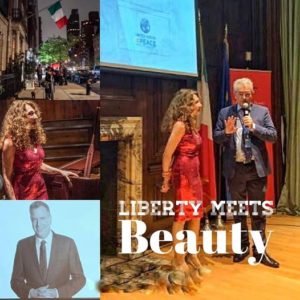
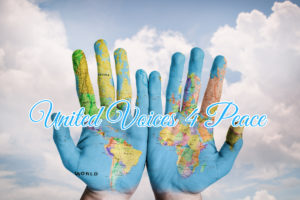
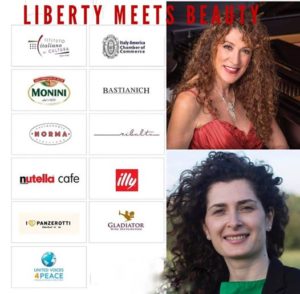
_________________________________________________________________________
RECOGNITION AWARD “GABRIELA MISTRAL, JULIA BURGOS Y FRIDA KALHO 2018” TO ROSA ANTONELLI
HONORED BY “GALO PLAZA INTERNATIONAL COMMITTEE”: New York , NY
“FOR BEING A WORLD RENOWNED PIANIST, PERFORMER AND PROFESSOR WHO WITH HER EXCEPTIONAL, TALENT, PRESTIGIOUS AND OUTSTANDING INTERNATIONAL CAREER, HER EDUCATIONAL AND CULTURAL COMMITMENT, SHE HAS PROMOTED THE HISTORY AND THE MUSIC OF THE CLASSICAL LATIN-AMERICAN COMPOSERS WITH EXCELLENCE WITHOUT FORGETTING HER ARGENTINIAN HERITAGE. SHE IS PROMOTING THE RECOGNITION OF THE ARGENTINIAN AND LATIN AMERICA CULTURAL IDENTITY, RISING THE PRESENCE OF THE HISPANIC SPEAKING COMMUNITY IN NEW YORK WHERE SHE RESIDES AND CULTIVATES THEIR INTEGRATION ALL OVER THE WORLD”
_________________________________________________________________________
Celebrating ALBERTO GINASTERA’S CENTENNIAL, Rosa Antonelli performed “IDILIO CREPUSCULAR” from Ballet Estancia at the Friars Club Auditorium.
The Lambs Foundation Piano Fund Drive
On October 24th, 2016, Rosa Antonelli will present a recital at New York’s new Steinway Hall to benefit The Lambs Foundation piano fund drive. Ms. Antonelli has been a member of the Lambs Foundation for many years. The program will be Classical Latin American Composers in honor of the celebration of Hispanic Heritage Month!
You can make a donation here: www.the-lambs.org/rosa/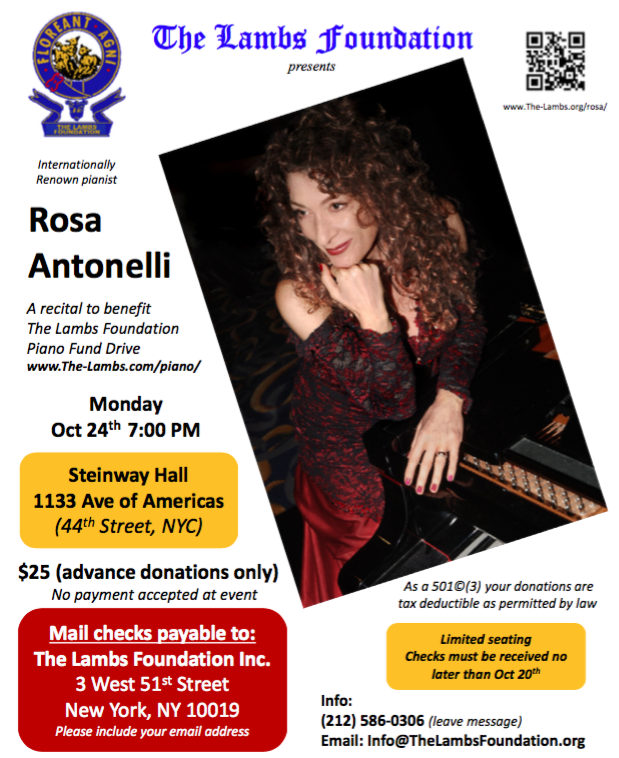
TV INTERVIEW NY1 Channel ROSA ANTONELLI – GEORGINA GINASTERA HOST : PHILIP KLINT
Acclaimed Pianist Rosa Antonelli Performs at the Argentina Consulate
Reviewer Nino Pantano, Pianist Rosa Antonelli & Commendatore Aldo Mancusi. Photo by Judy Pantano
As part of the Alberto Ginastera Centennial celebration, the gifted Argentine-American pianist Rosa Antonelli gave a concert on Wednesday, May 18th at the Consulate General and Argentine Republic at 12 West 56th Street in Manhattan. The special guest in attendance was Alberto Ginastera’s daughter Georgina Ginastera.
Rosa Antonelli has been hailed as a leading exponent of Spanish and Latin American music and has appeared at many venues worldwide as well as Carnegie Hall and Lincoln Center. Ms. Antonelli’s two CDs titled “Esperanza” and “Remembranza” have been acclaimed. I am proud to have her newest “Abrazando-Latin Embrace” in which she demonstrates her pianistic wizardry with several immortal Latin composers including Astor Piazzolla, Hector Villa-Lobos, Ernesto Lecuona and Isaac Albeniz.
I first became acquainted with Ms. Antonelli at a gala at the New York Athletic Club sponsored by the Enrico Caruso Museum based in Brooklyn. Aldo Mancusi, the founder and curator of the museum chanced to hear Ms. Antonelli play at a concert and asked her if she would play a selection or two at his special gala honoring his new title of Commendatore by the Italian government. She did play and later requested that we attend her special concert at the Argentine Consulate.
Ms. Antonelli, looking stunning in a sparkling red and silver gown, seated at her beautiful Steinway piano began playing “Idilio Crepuscular” (Romance at Twilight) from Ballet Estancia, the first part of a set by the Argentine composer Alberto Ginastera (1916-1983) and then from “Preludios Americanos” “Triste,” “Vidala” and “Homenaje” a Roberto Garcia Morillo. The tone poems of Ottorino Respighi could be heard in the vibrant rhythms of Pastoral with its dreamy introspection and the exuberant “Danza Criolla.” Ms. Antonelli and her instrument play as one and she is an amazing phenomenon.
The passionate rhythms and melodic outbursts of Astor Piazzolla (1921-1992) followed. His four tangos entitled “El Mundo De Los Dos,” “Verano Porteno,” “Invierno Porteno” and “Libertango” were played with enormous zest. The tango like themes entwining like two dancers in an orgiastic blend in an explosion of passion. One could envision the dancers, drenched in sweat, breathing heavily, totally spent from this orgy of breathtaking musical madness. Ms. Antonelli left us all bedazzled.
The final group, again by Ginastera was from “Danza del Trigo” (Wheat Dance from Ballet Estancia) “Tres Danzas Argentinas,” “Del Viejo Boyero,” “De la Moza Donosa” and “Del Goucho Matrero.” All played with dexterity, finesse and strength fueled by an Argentine inner fire that warmed the soul and stirred the blood.
At the reception we met so many devotees of the art of Rosa Antonelli, who like fellow Argentine Pope Francis is of Italian ancestry. The trials of our being in a traffic jam earlier were drowned out by the beauty of the concert and the delicious meat and vegetable Empanadas, wines and cheeses served afterwards. I have relatives in Buenos Aires that we lost touch with and this concert in a spiritual way, brings me closer to them.
Ms. Antonelli was given a beautiful bouquet of flowers and we thank her for the unforgettable “bouquet” of musical roses she gave to all in attendance.
This entry was posted in Italian -American Heritage and tagged 2016, rosa antonelli by Nino Pantano. Bookmark thepermalink.
AMERICAN RECORD GUIDE Jan/ Feb 2016
Review
ROSA ANTONELLI, Piano
Abrazando: Latin Embrace
Piazzolla, Villa-Lobos, Ponce, Williams, Lecuona,
Albeniz, Gianneo
Rosa Antonelli, p—Albany 1571—59 minutes
“Latin Embrace” is the right title for this album. These are some of the sexiest pieces in the repertory; and Rosa Antonelli, a specialist with this tradition, mostly chooses the languid specimens rather than the raucous ones. The album opens with Piazzolla’s atmospheric ‘Invierno Porteno’ and ‘Verano Porteno’, played with generous rubato. Villa-Lobos’s Bachiana
Prelude 1 offers immediate contrast. It’s always a treat to hear the exotic, free-spirited music of Cuban composer Ernesto Lecuona. (His popular ‘Malaguena’ is practically all we ever get.) Antonelli plays the gently ringing ‘Bell-Flower’ and an aptly named ‘Marvelous Waltz’. We also get a waltz from Albeniz, which Antonelli performed in its American premiere in her 2014 Carnegie Hall recital. My favorite pieces are an Intermezzo and ‘Romanza De Amor’ by Ponce. I’ve always had a fondness for this supremely seductive, gentle, unaccountably obscure composer. Antonelli’s phrasing and voicing are magical. The recorded sound is a bit cramped for such luscious stuff, but this is highly recommended. by SULLIVAN
American Record Guide – Review Link
MORE ABOUT ROSA ANTONELLI PERFOMANCES AT CARNEGIE HALL IN 2011 AND 2014
NEW CD:
ABRAZANDO Latin Embrace
(Click image to enlarge)
REVIEWS:
Rosa Antonelli
WORLD RENOWNED STEINWAY ARTIST
Argentine pianist Rosa Antonelli is enjoying an active and varied performance career. “Her artistic insight and flawless technique are combined to create an impressive musical vision.” Ms. Antonelli is proud that in 1998 she was asked to become part of the distinguished Roster of Steinway Artists.
Ms. Antonelli’s recent performance highlights include Carnegie Hall -Stern Auditorium /Ronald O. Perelman Stage-, where she performed the World Premieres of Astor Piazzolla’s Two Tangos and The Allen Room, Frederick P. Rose Hall Home of Jazz at Lincoln Center.

